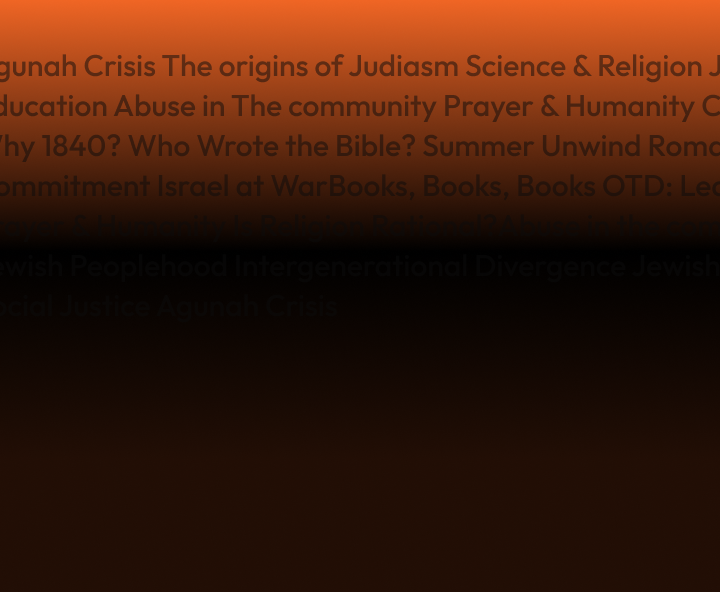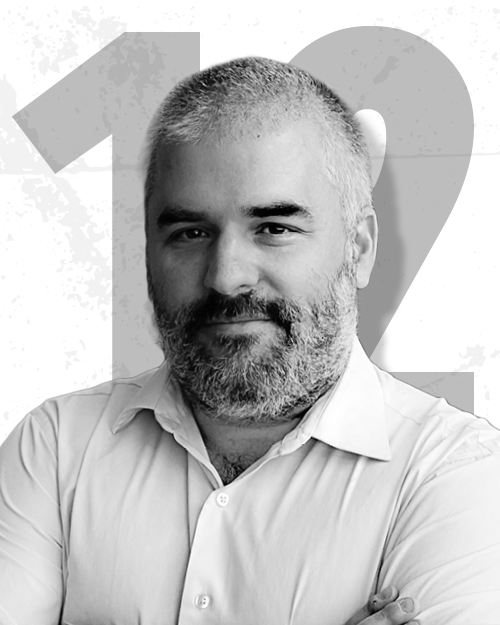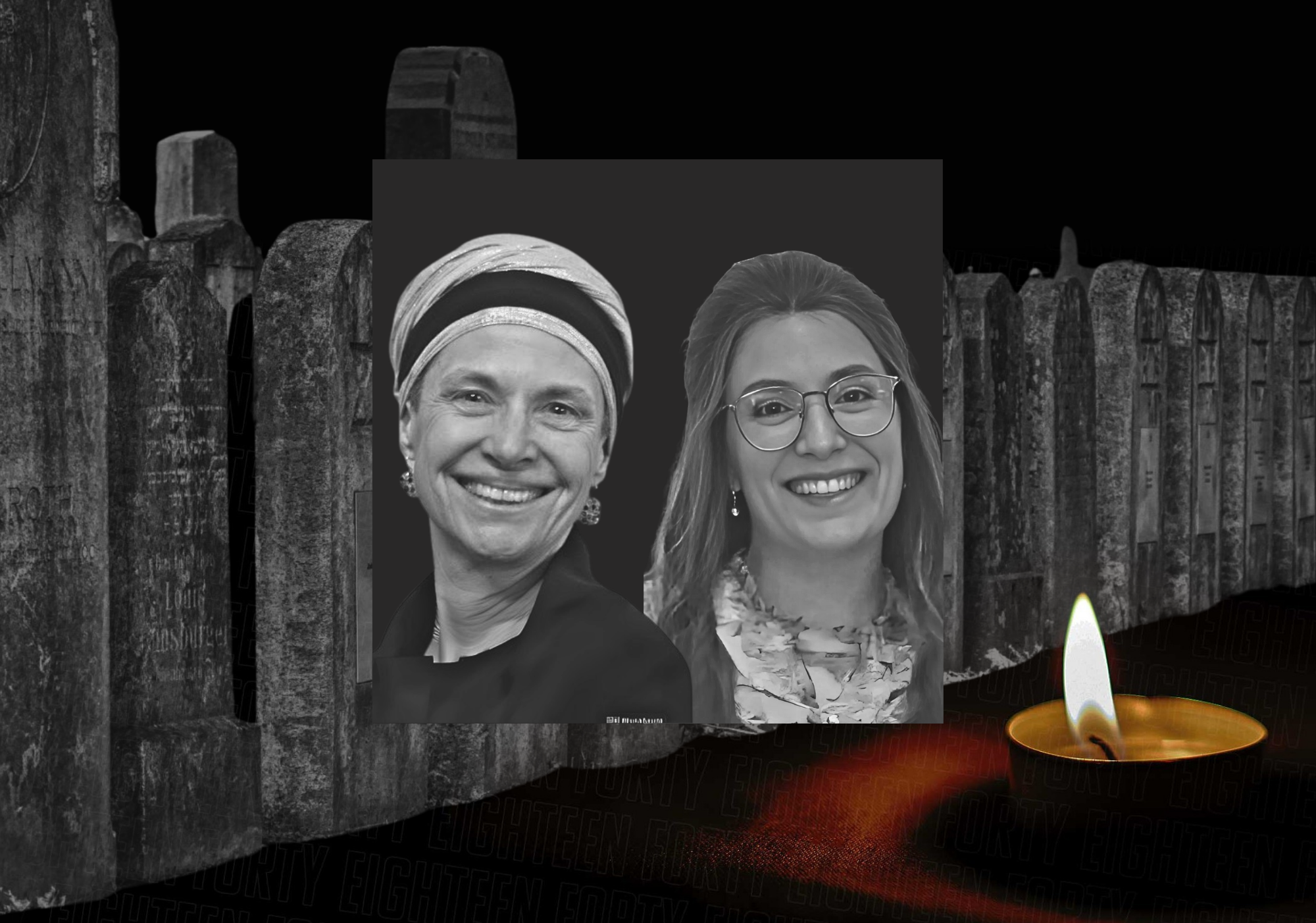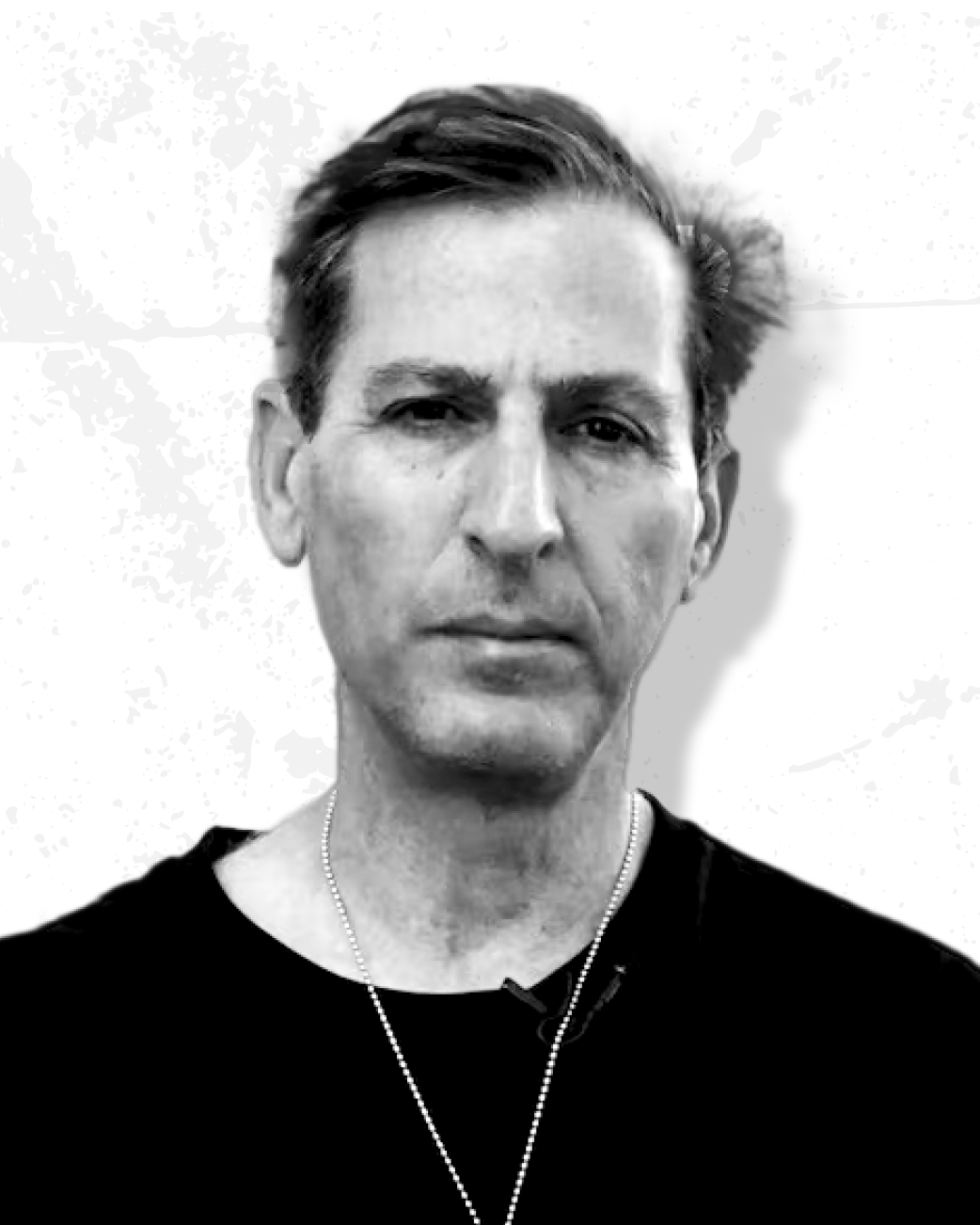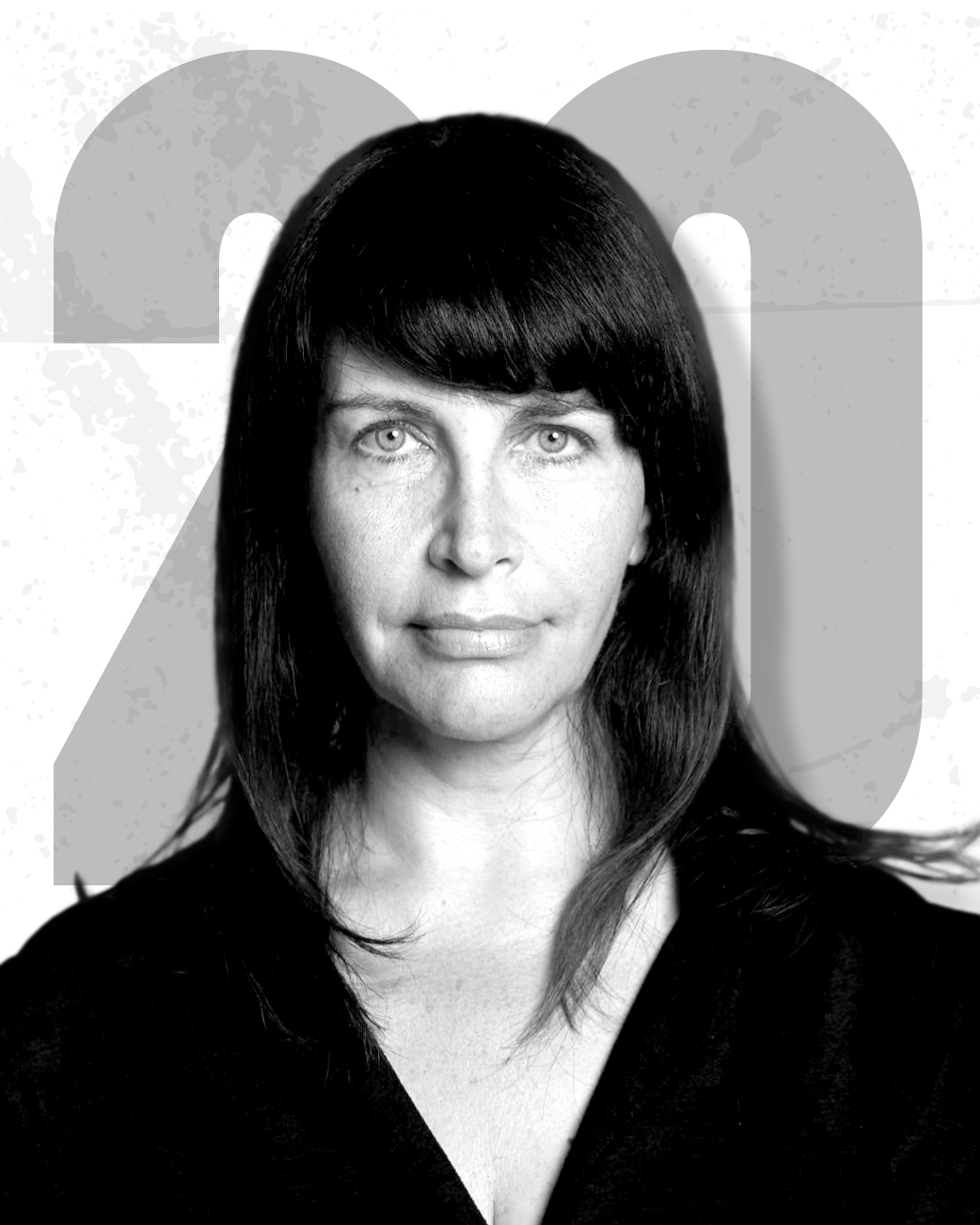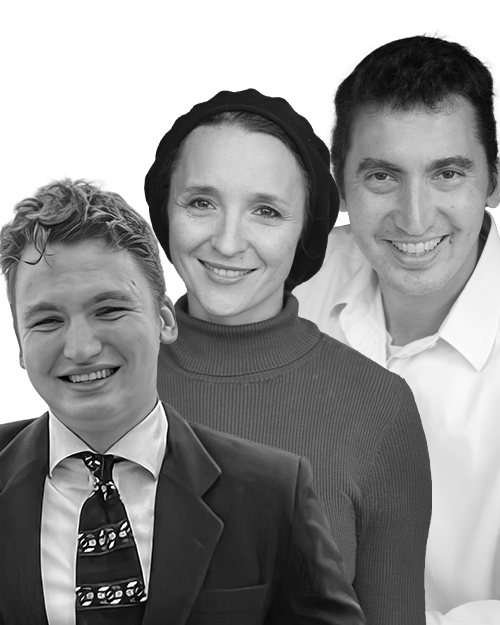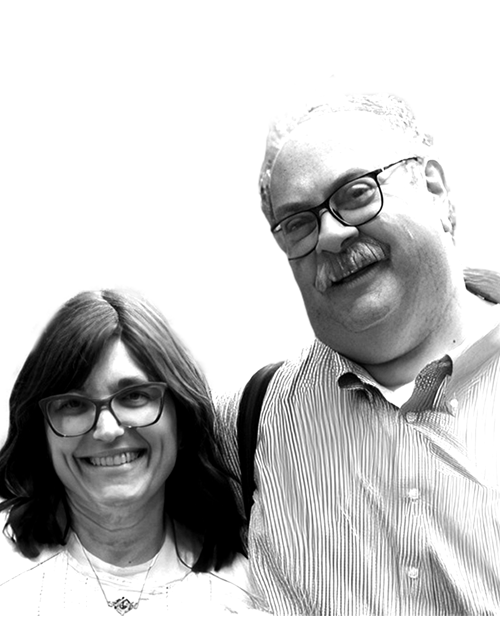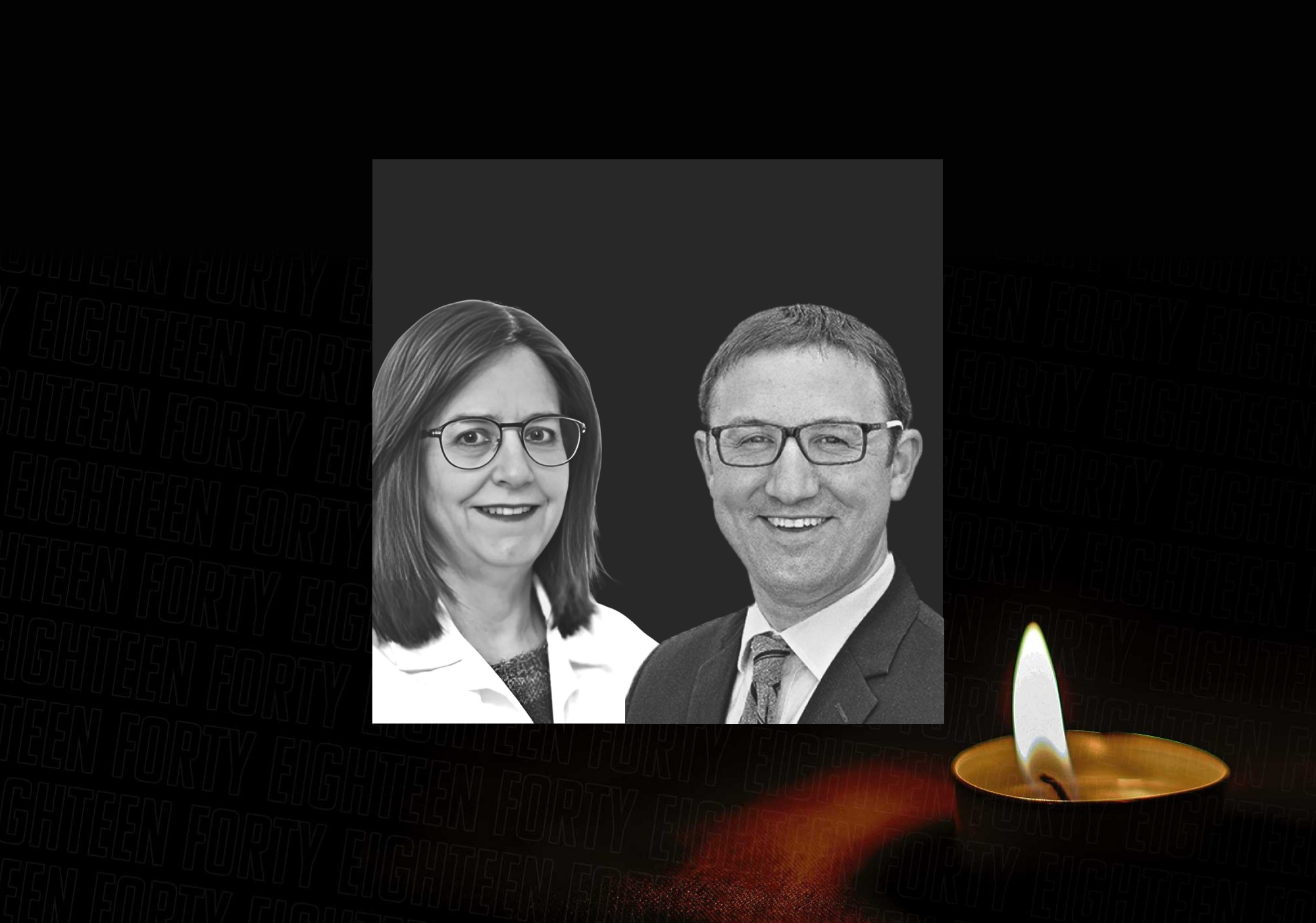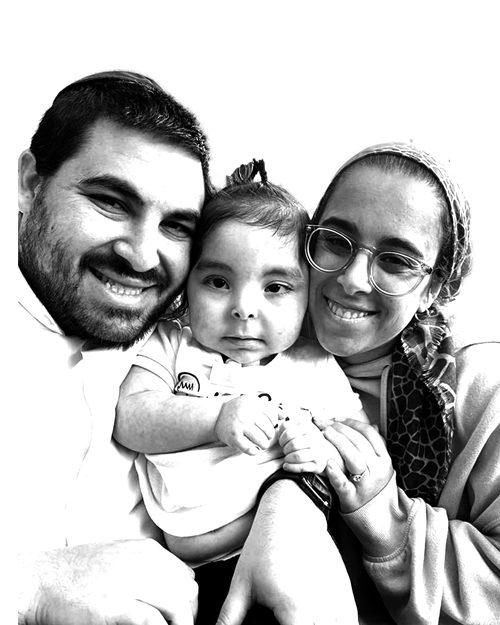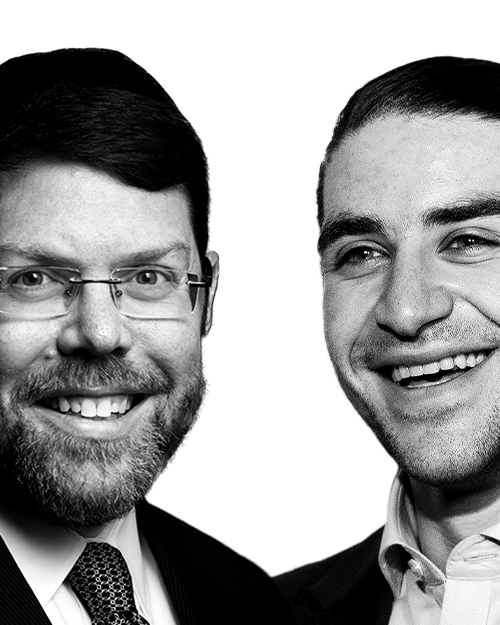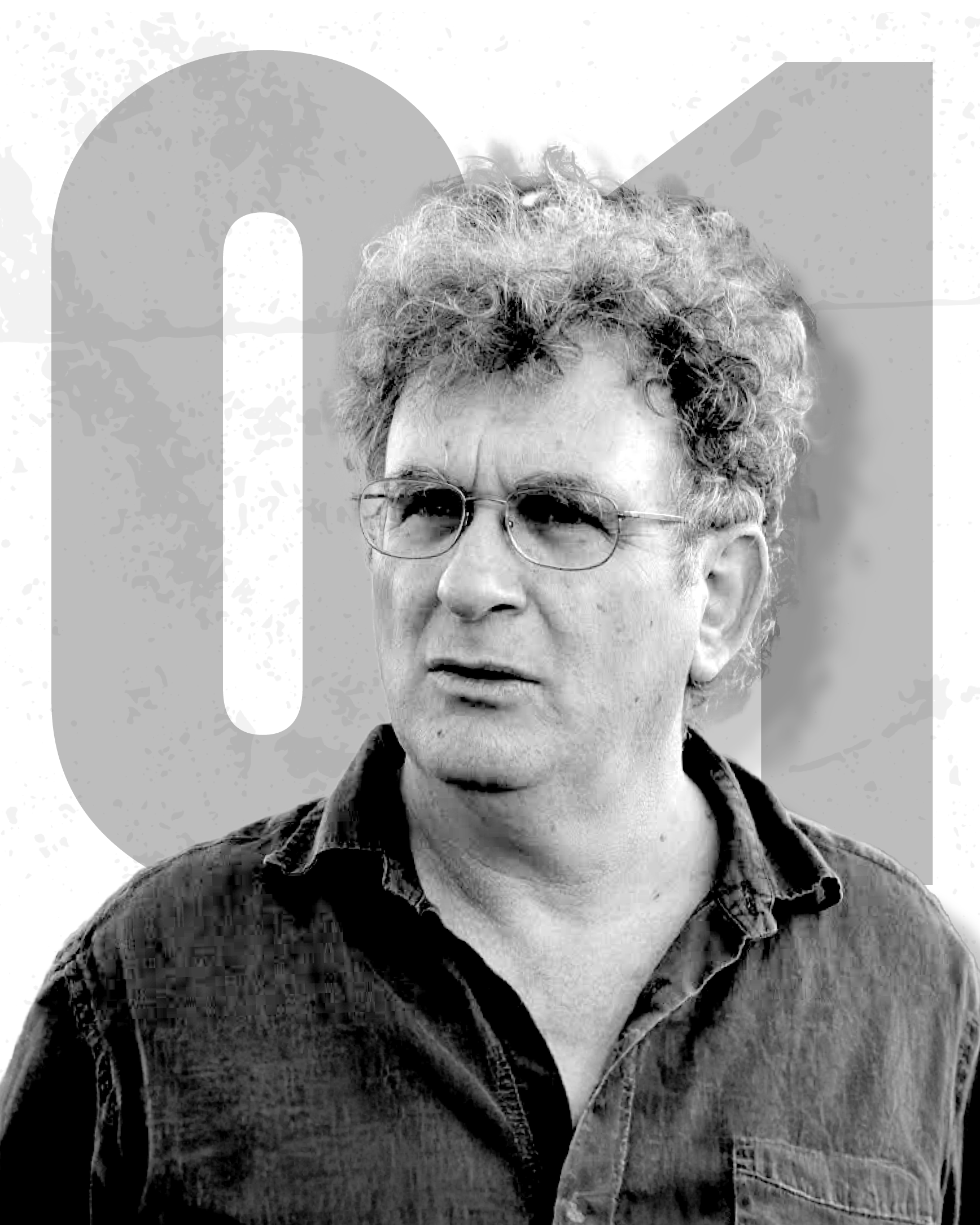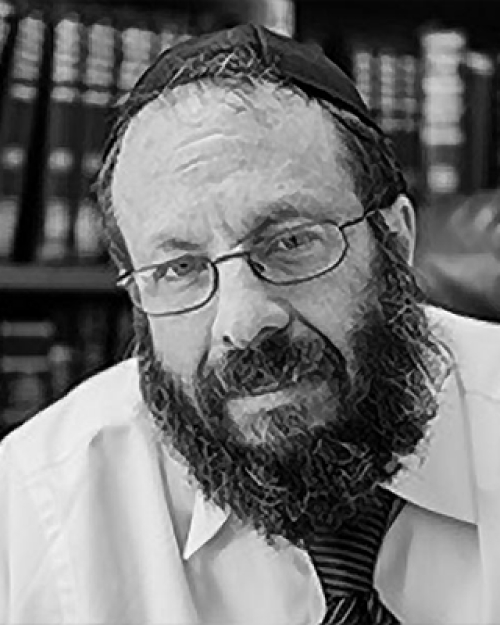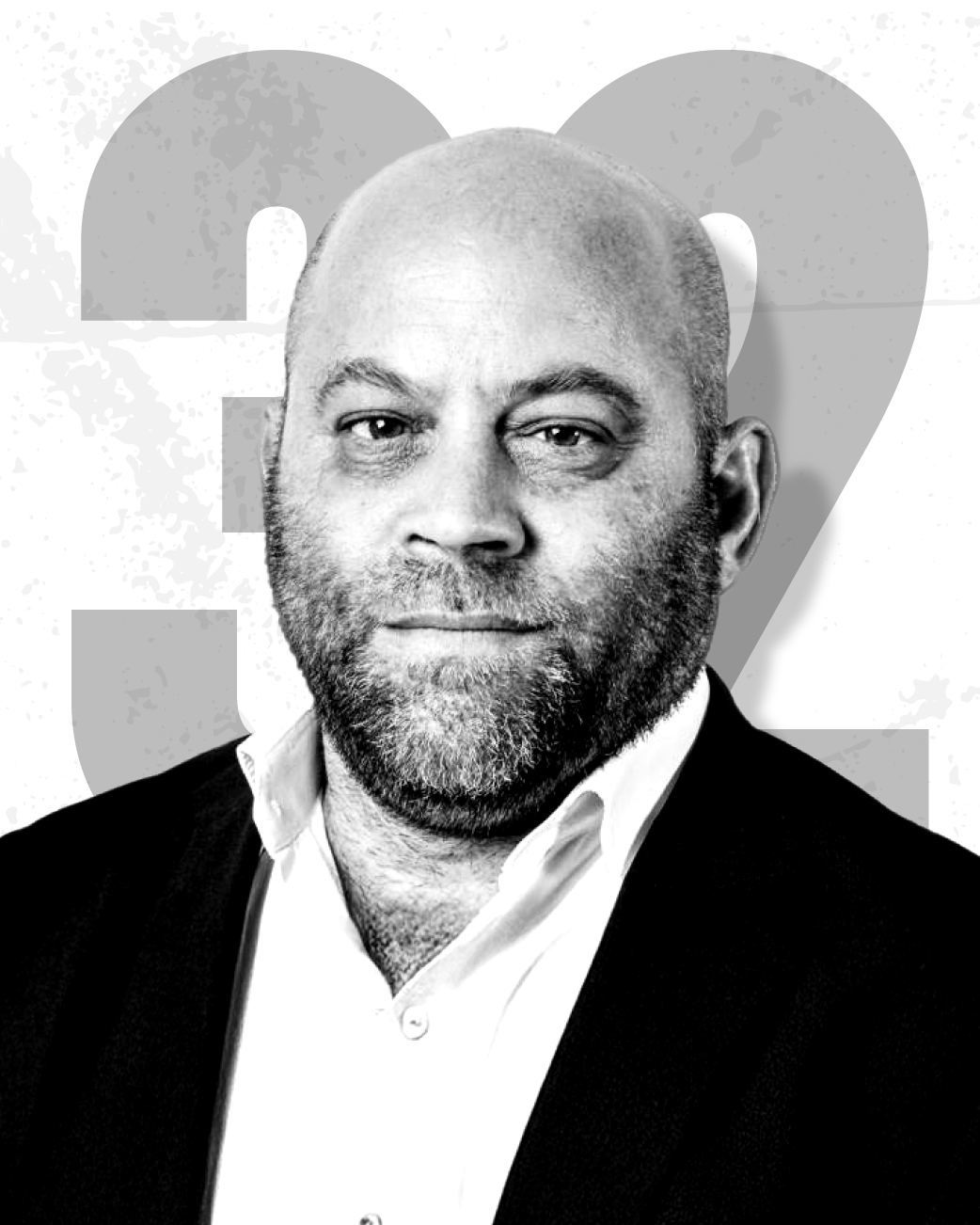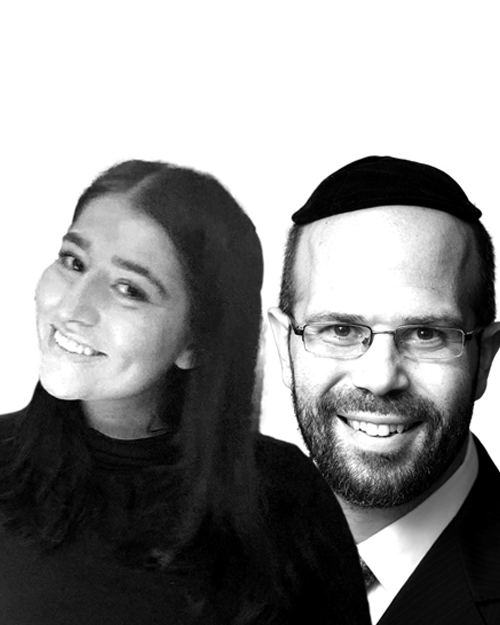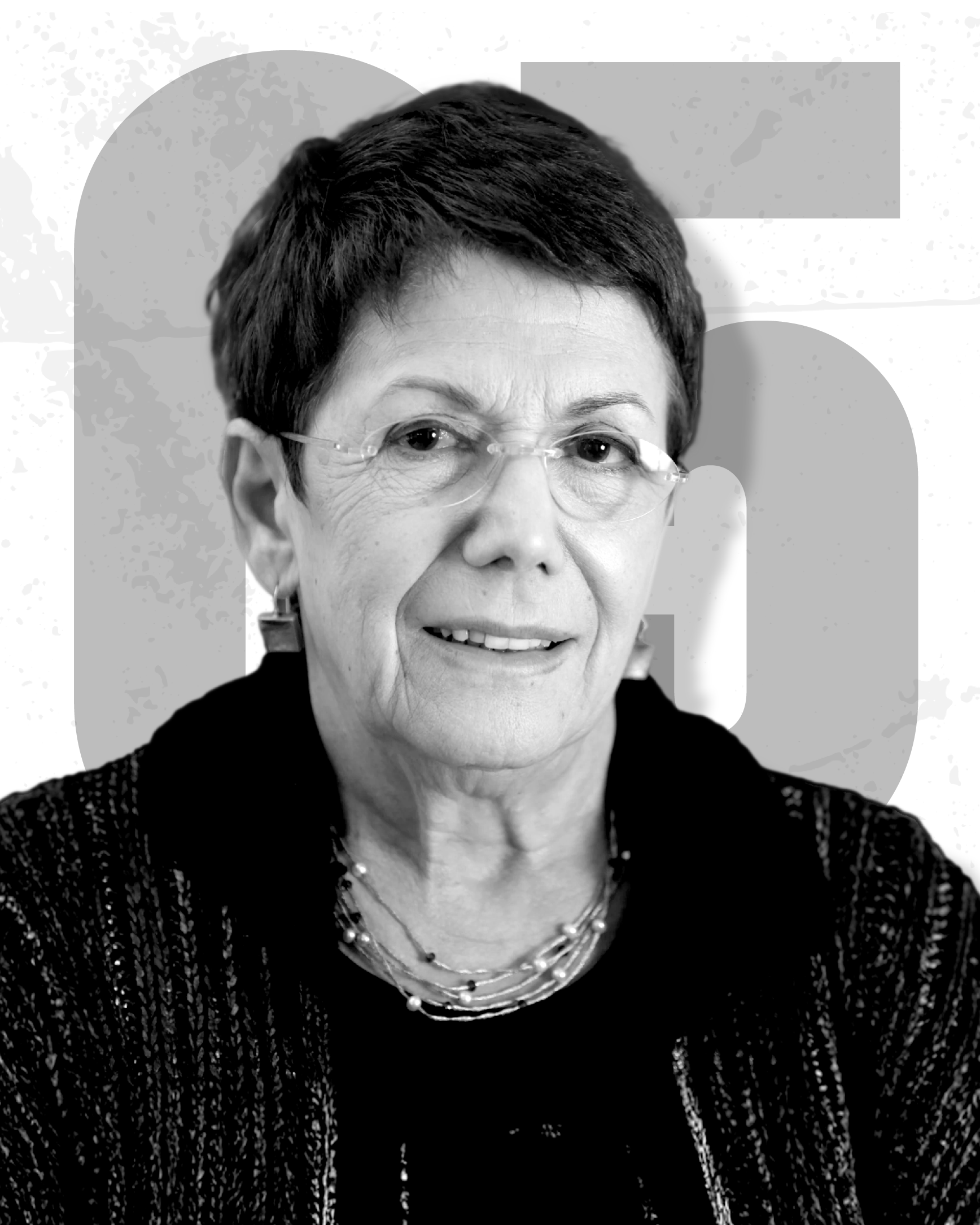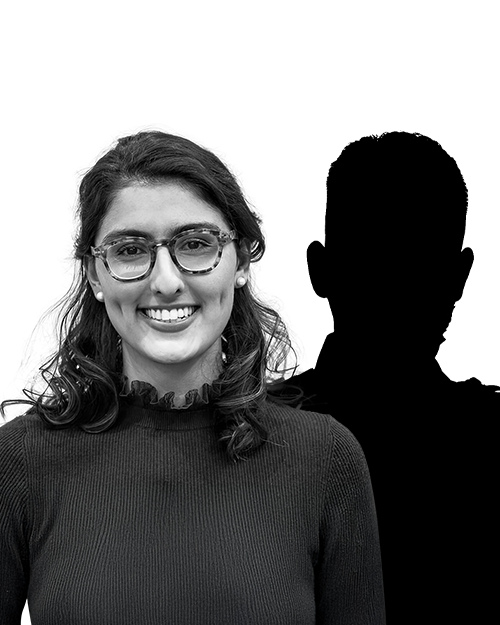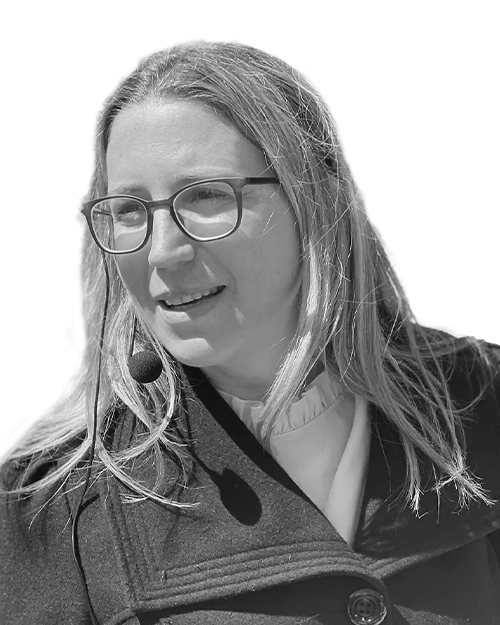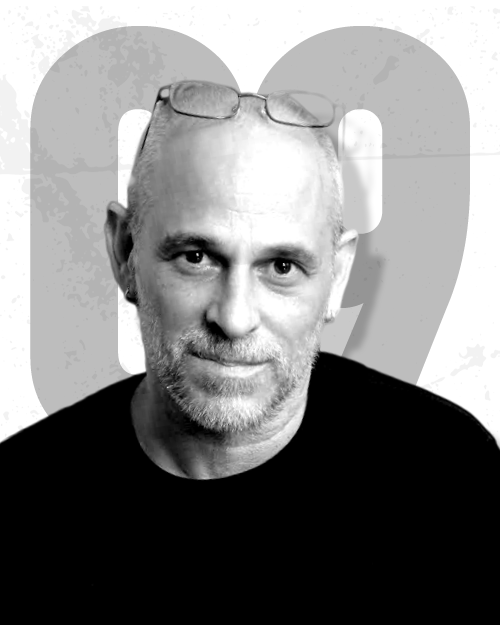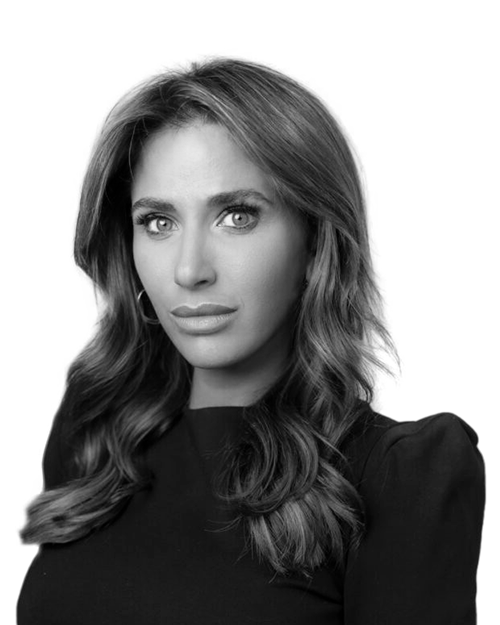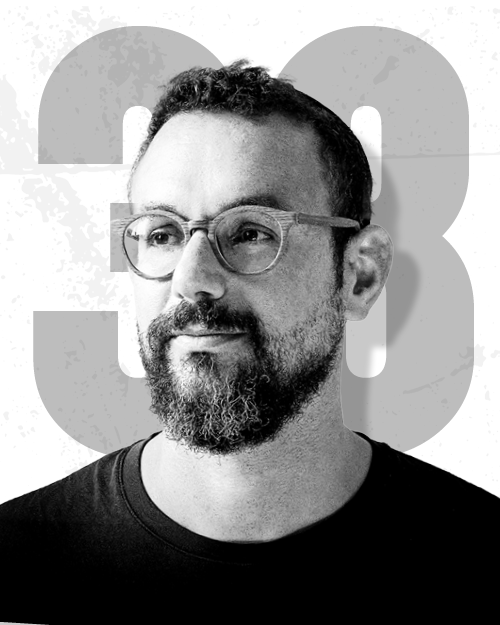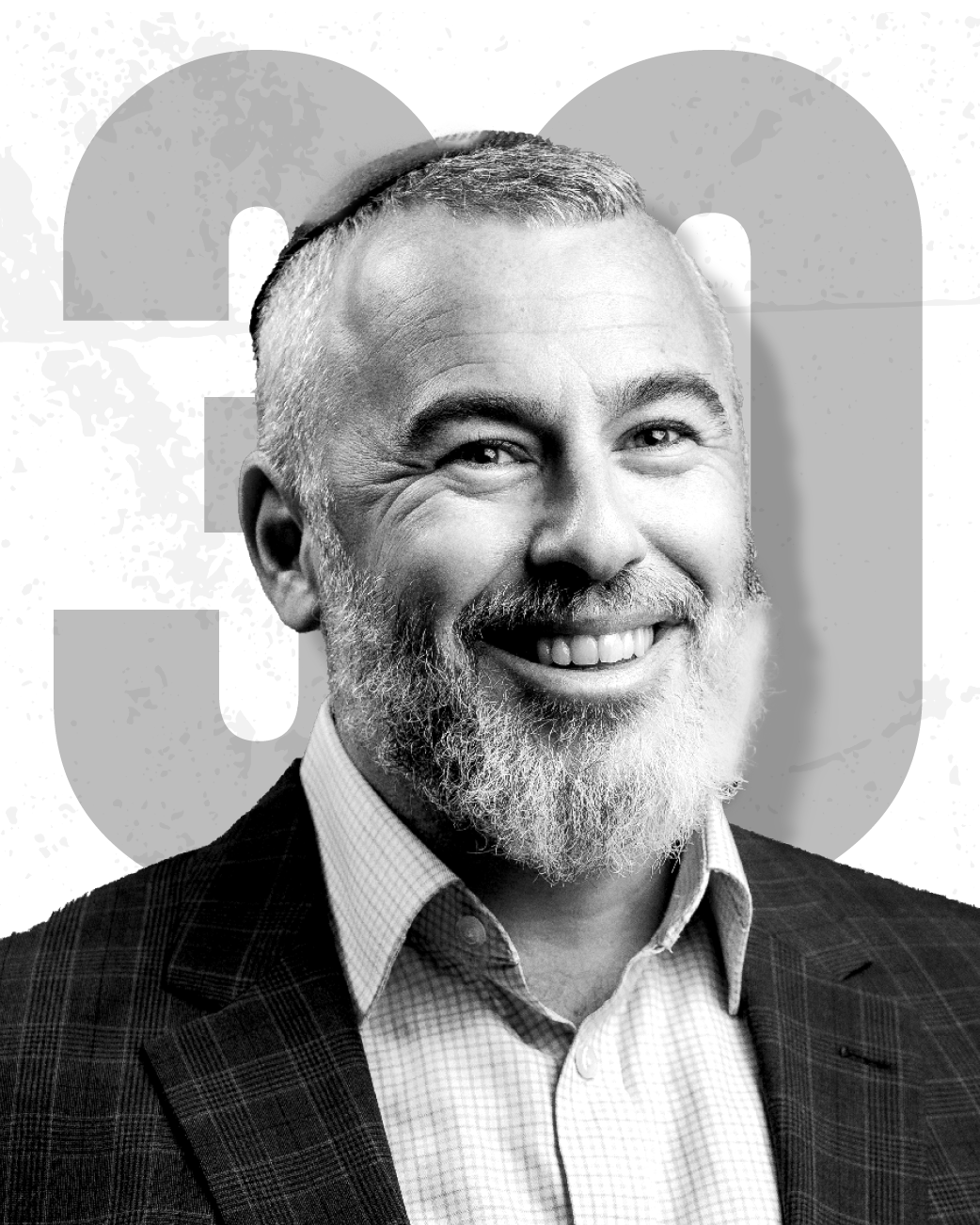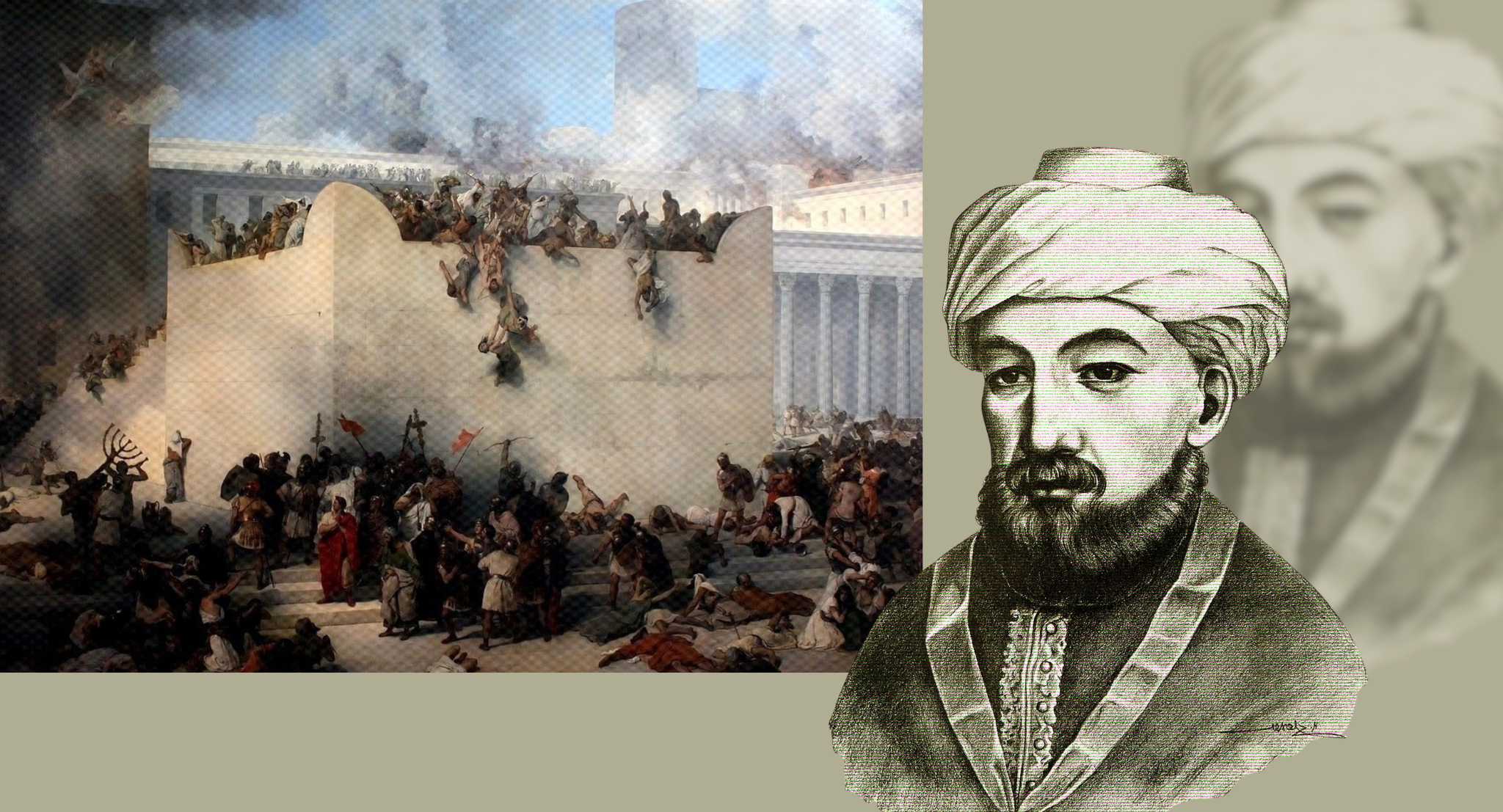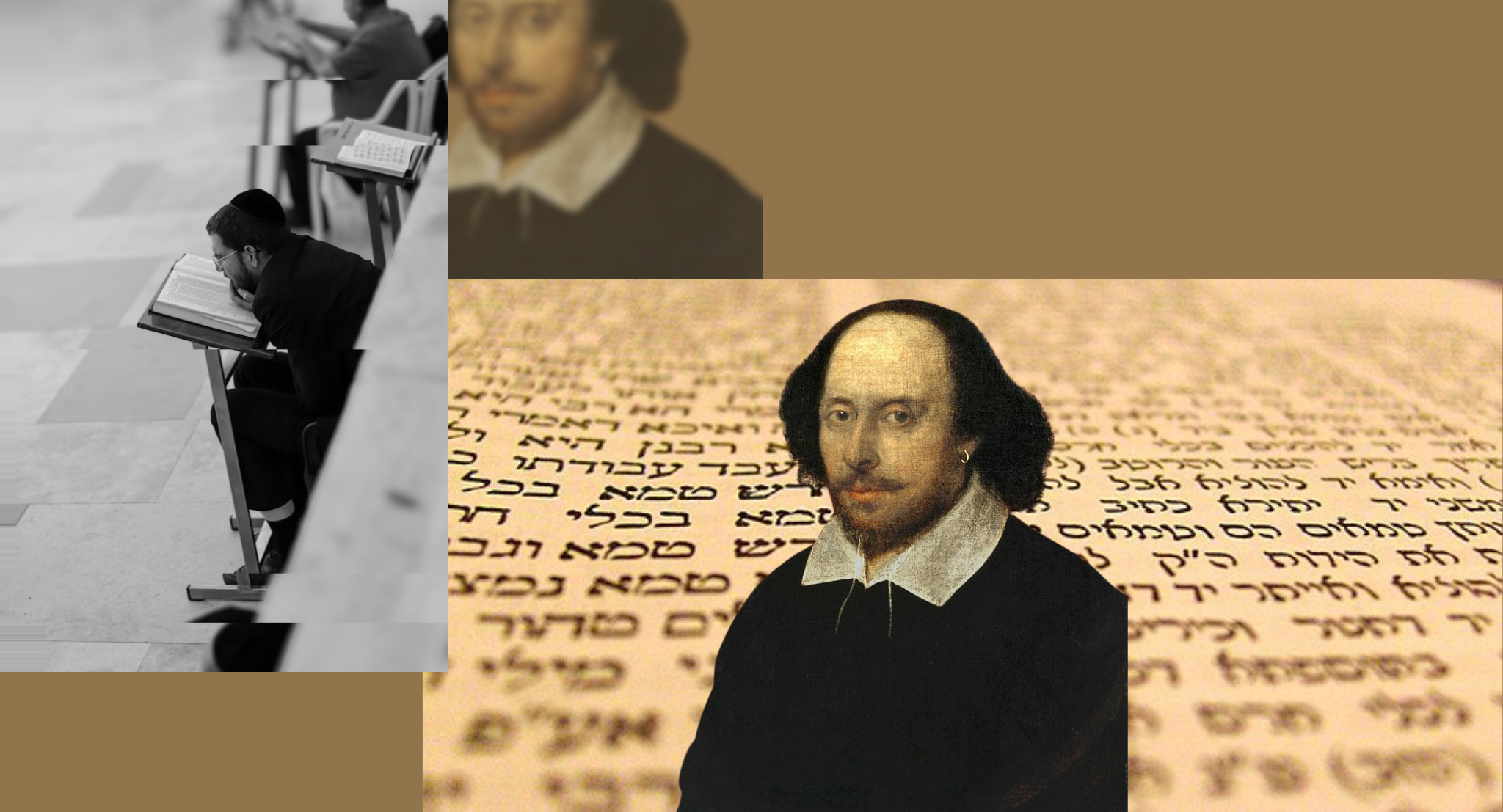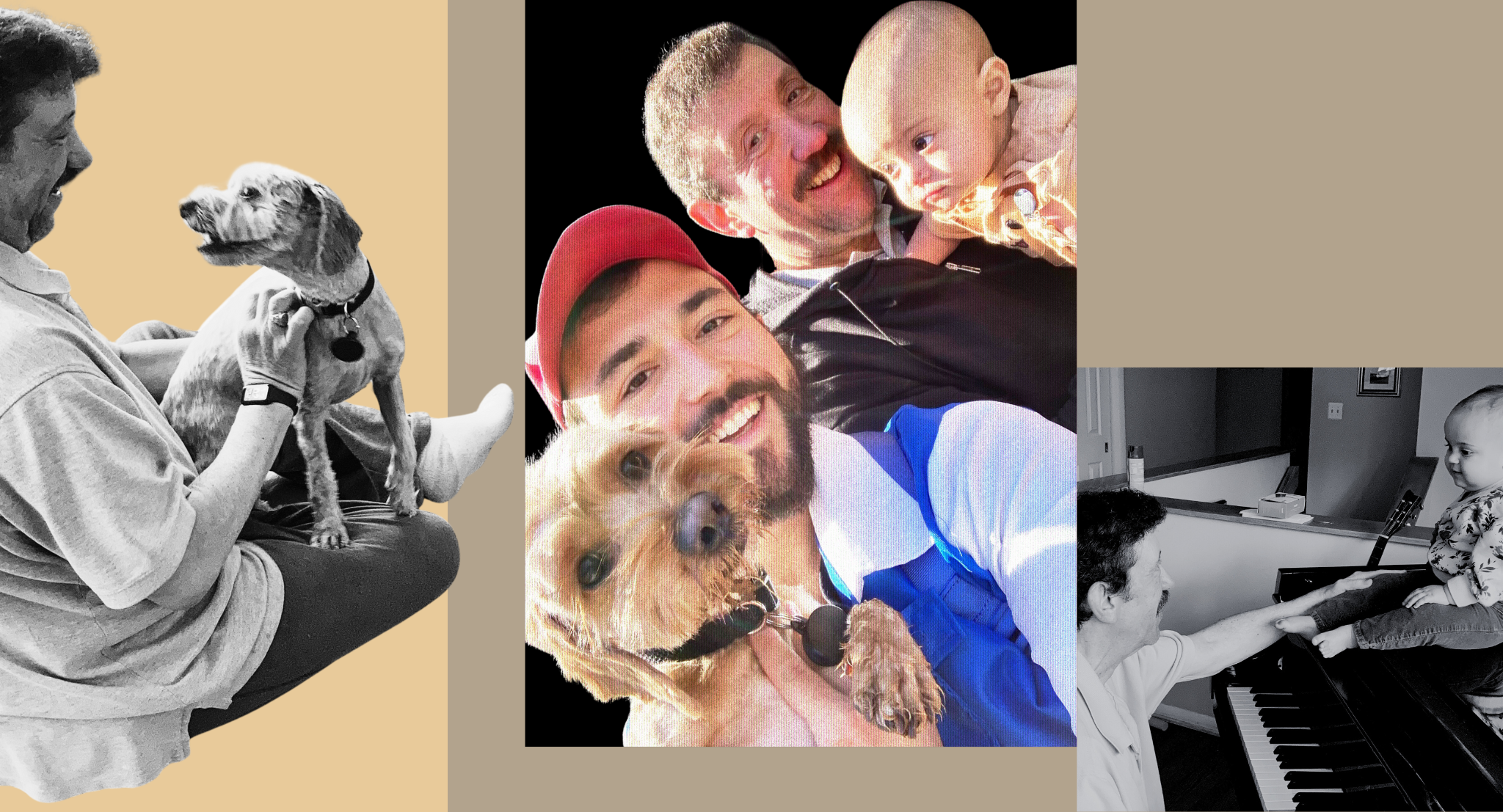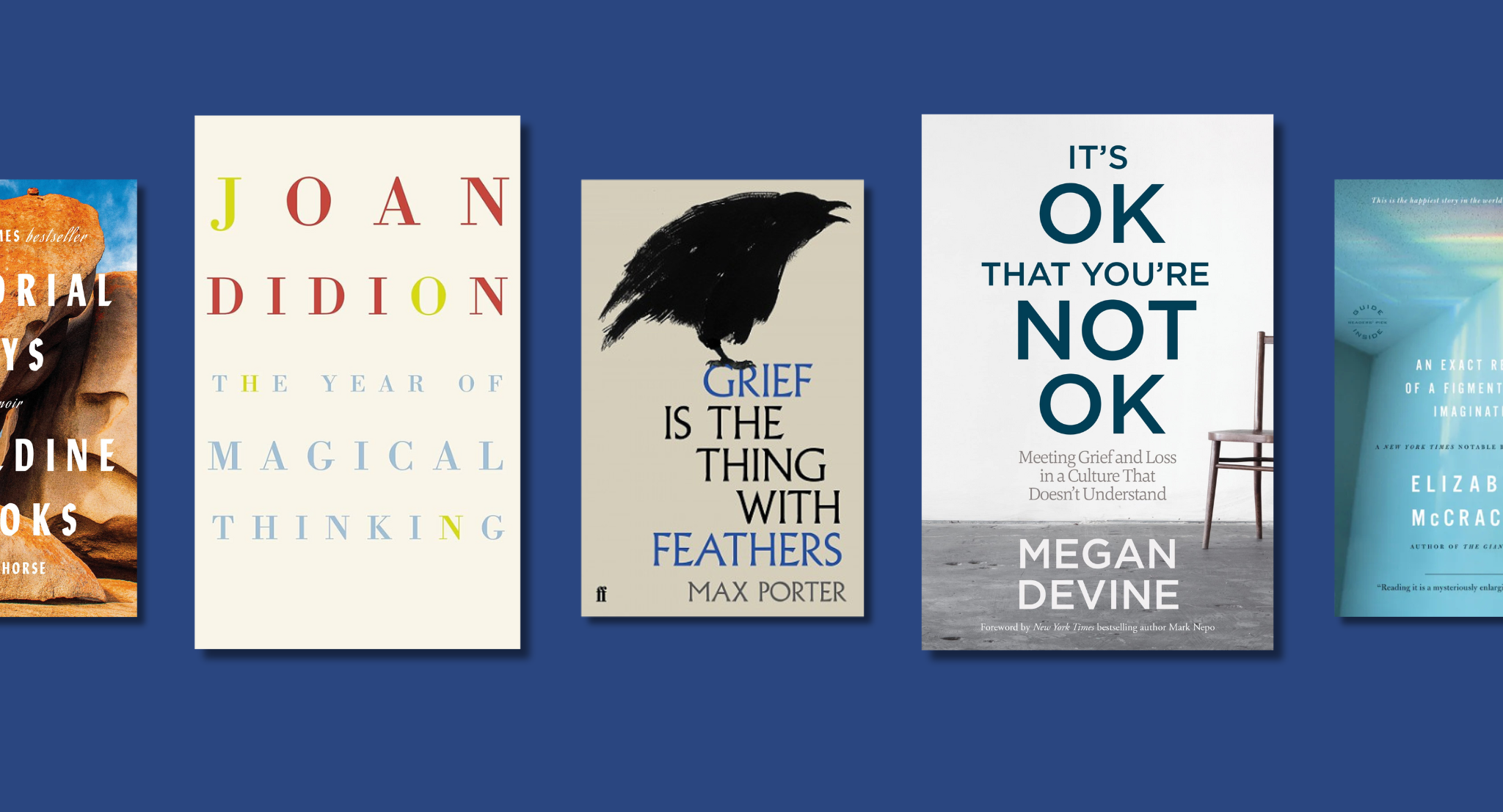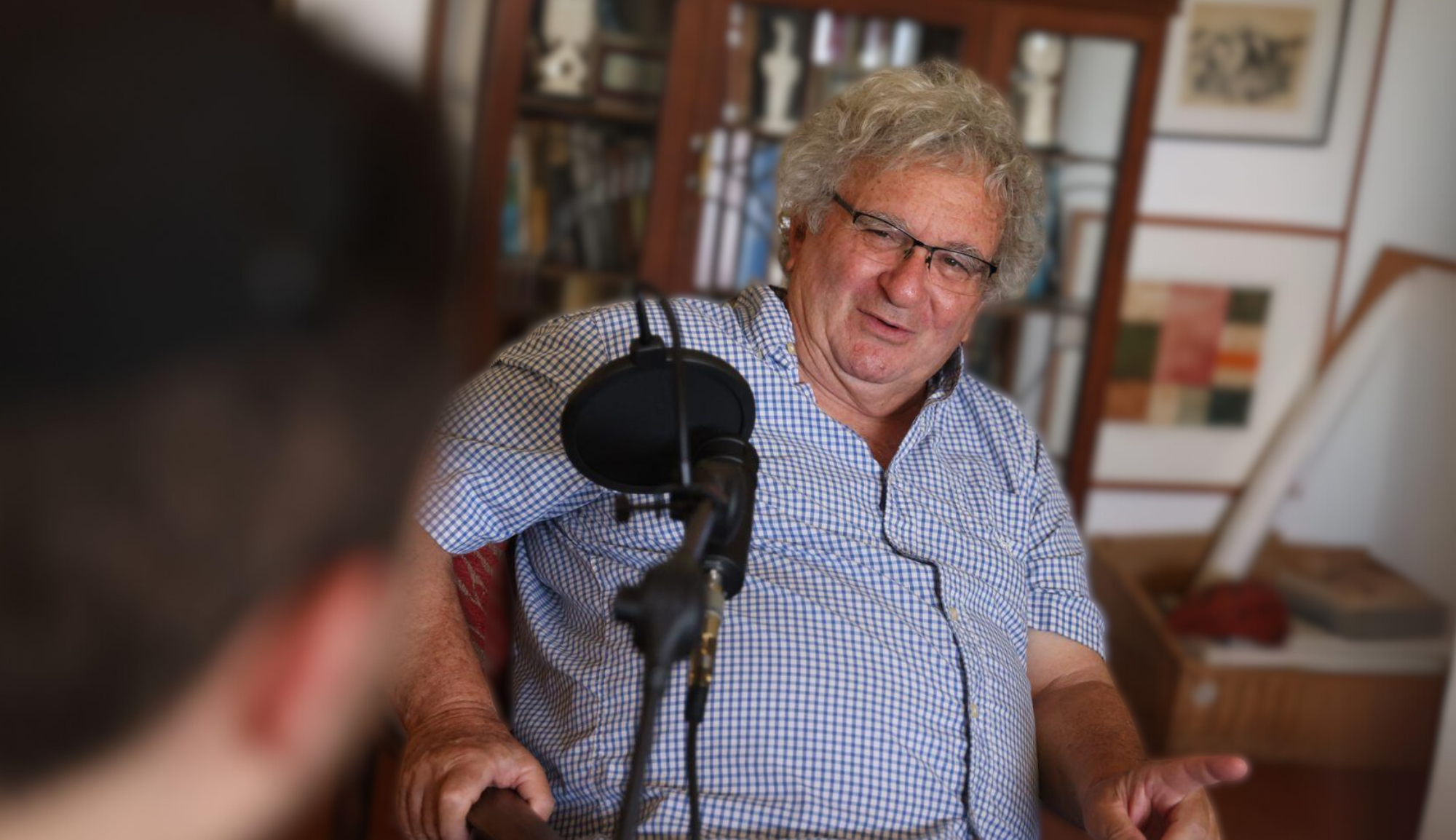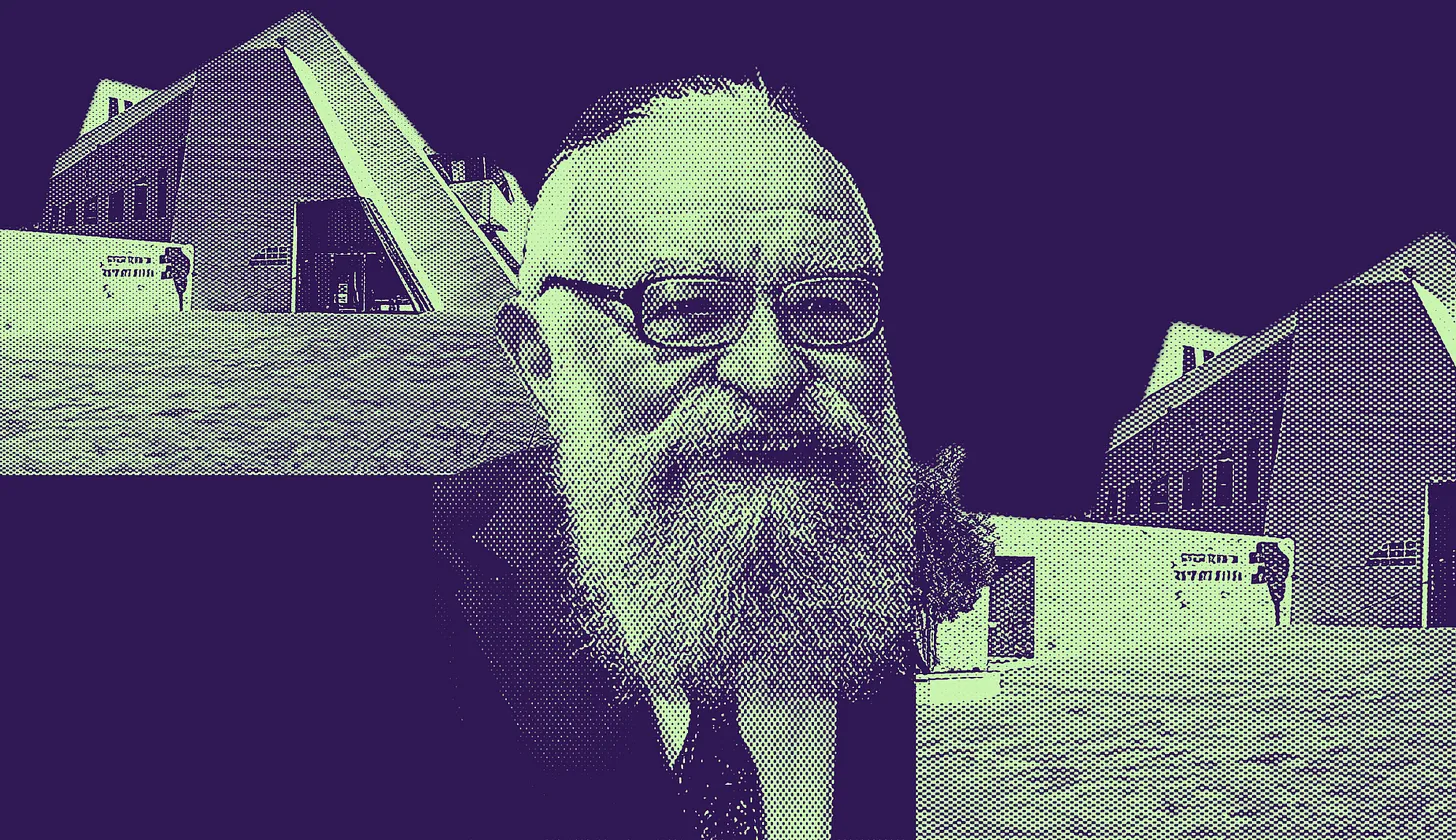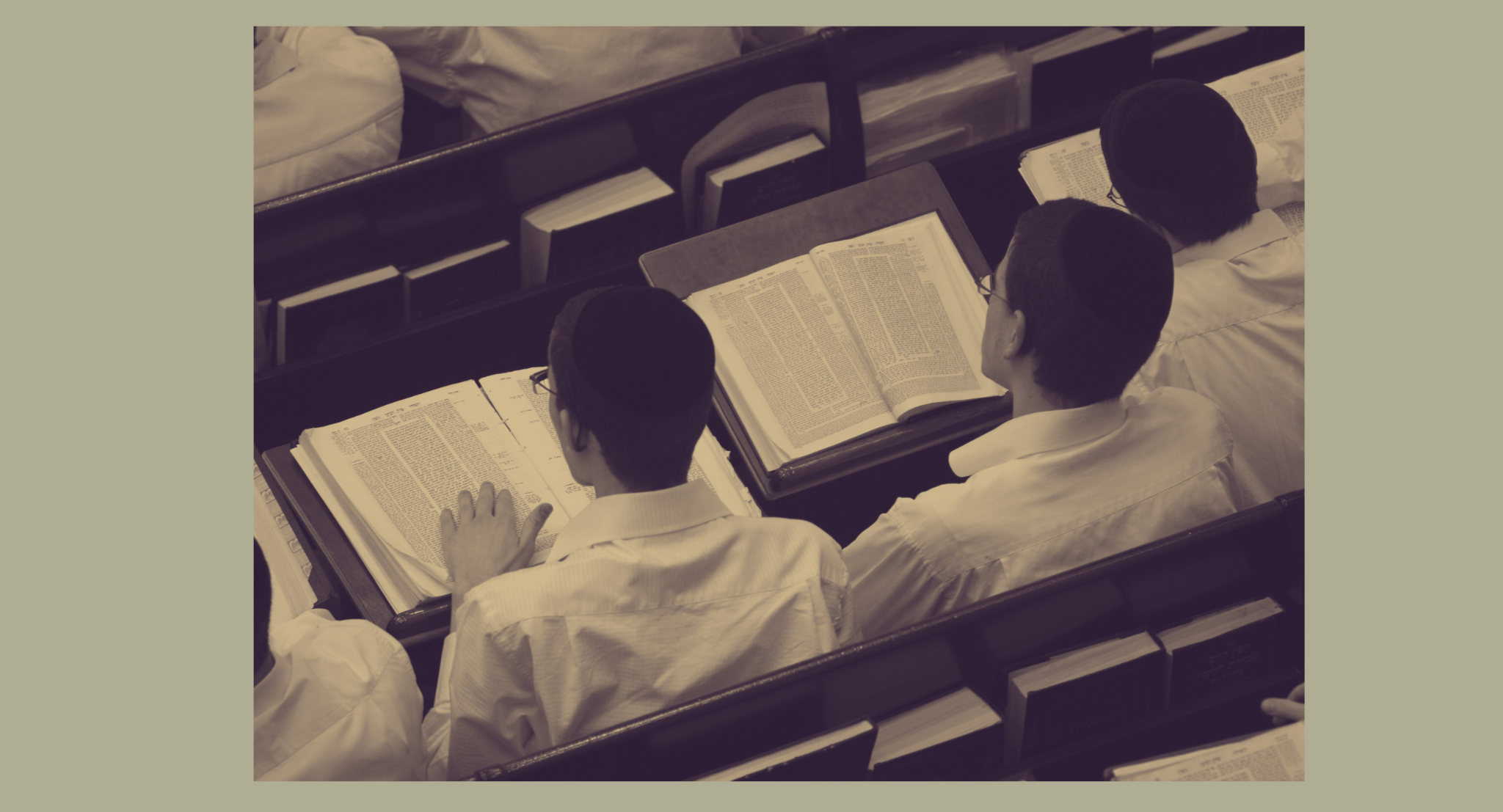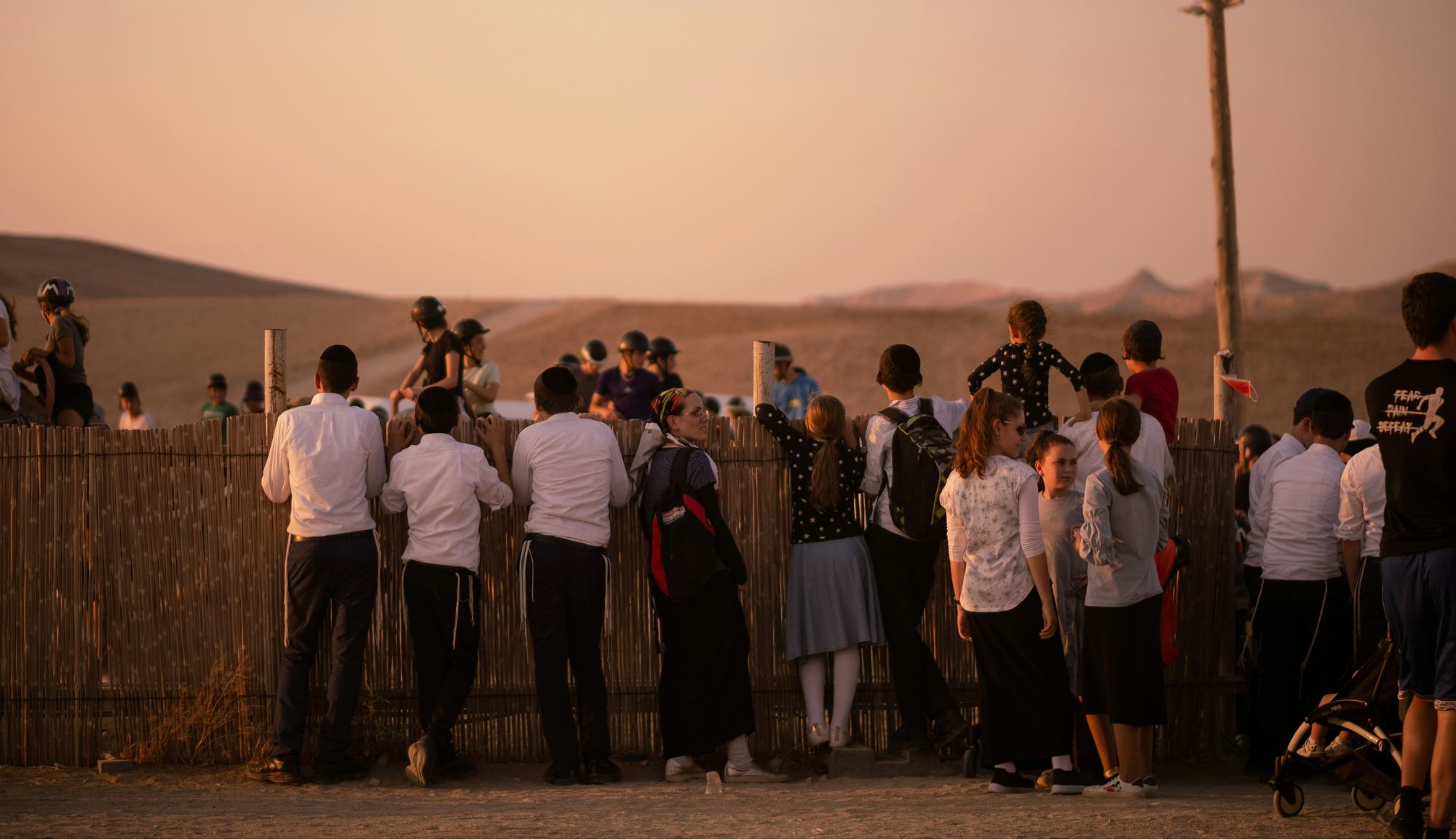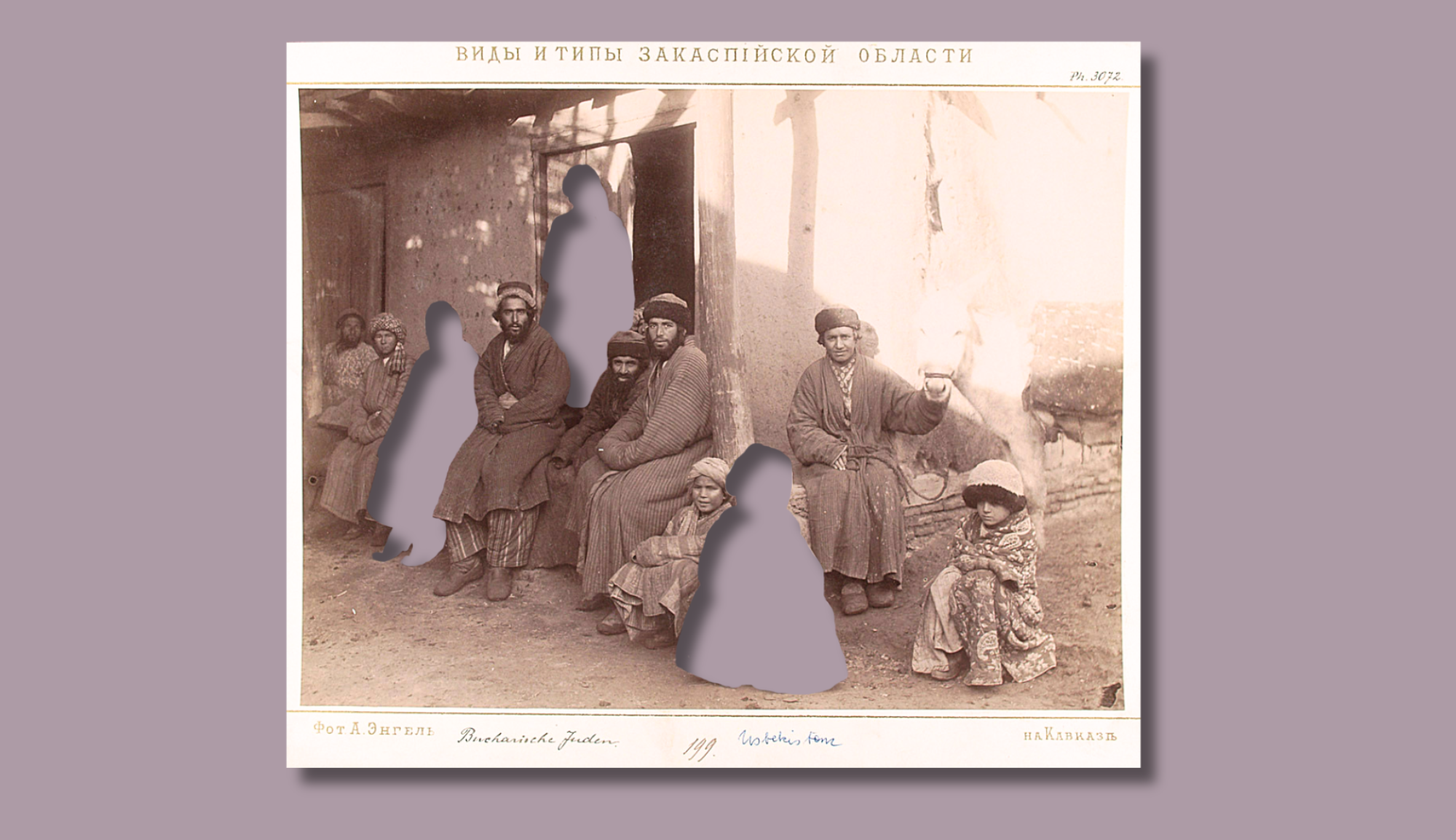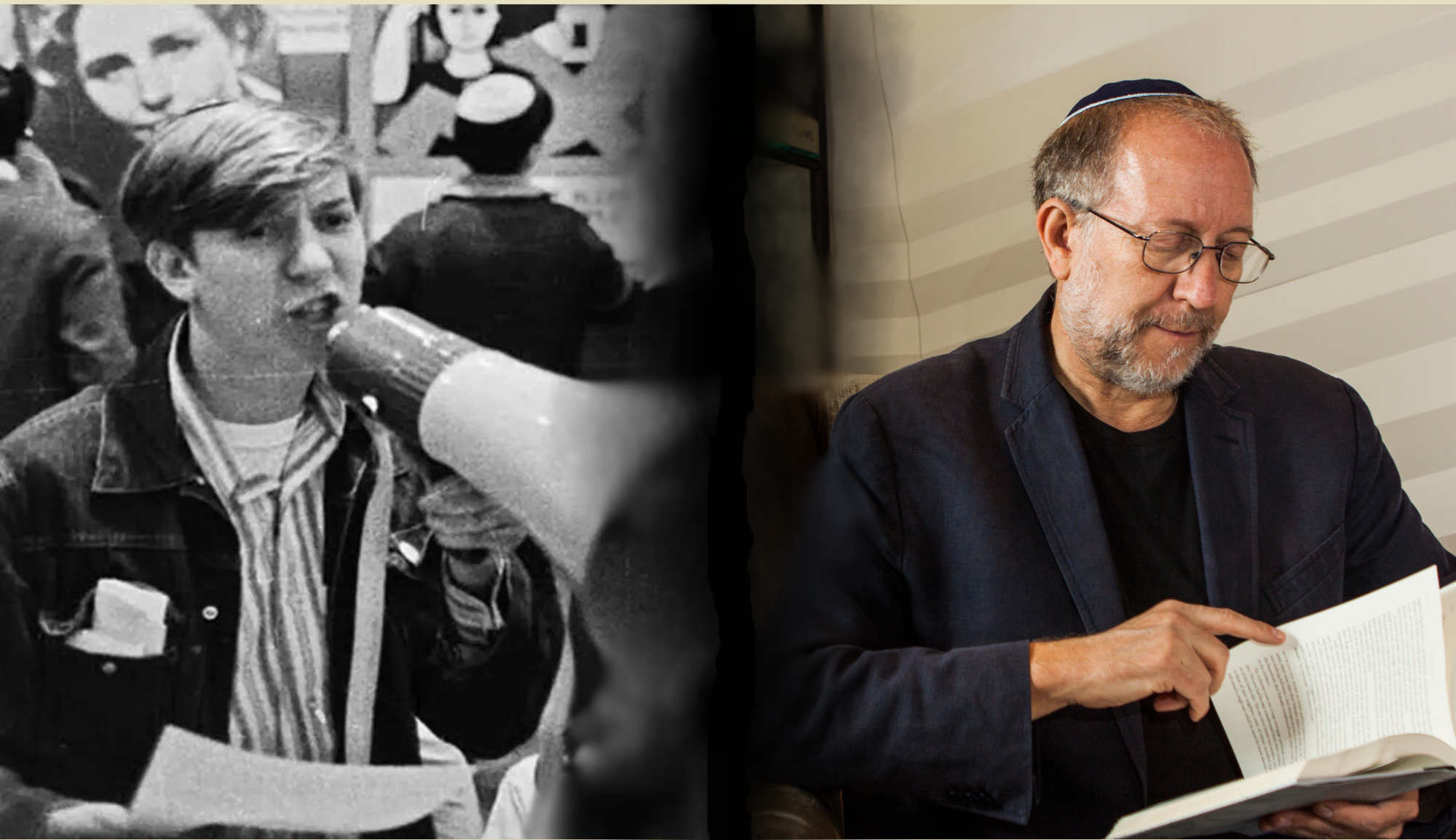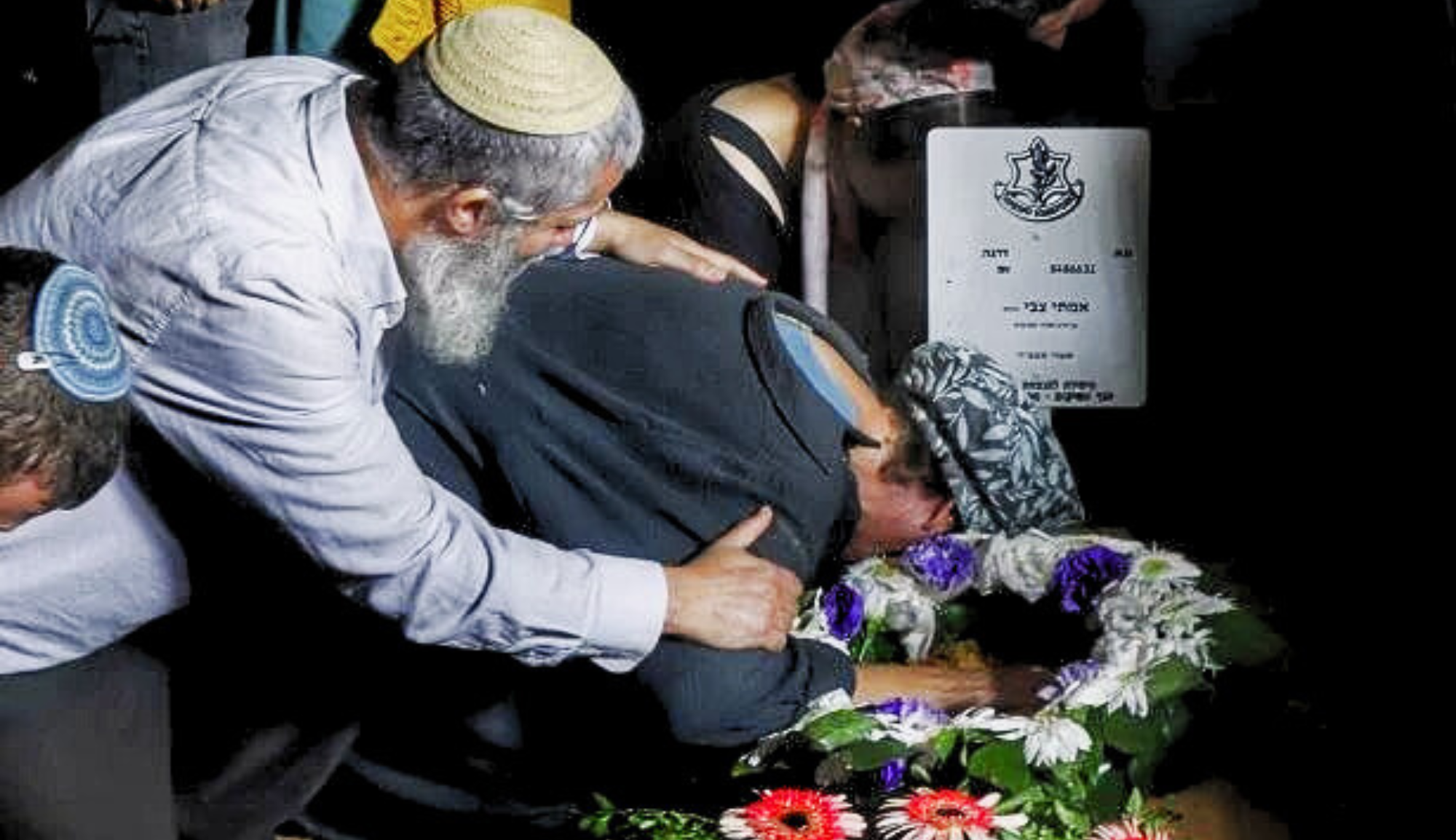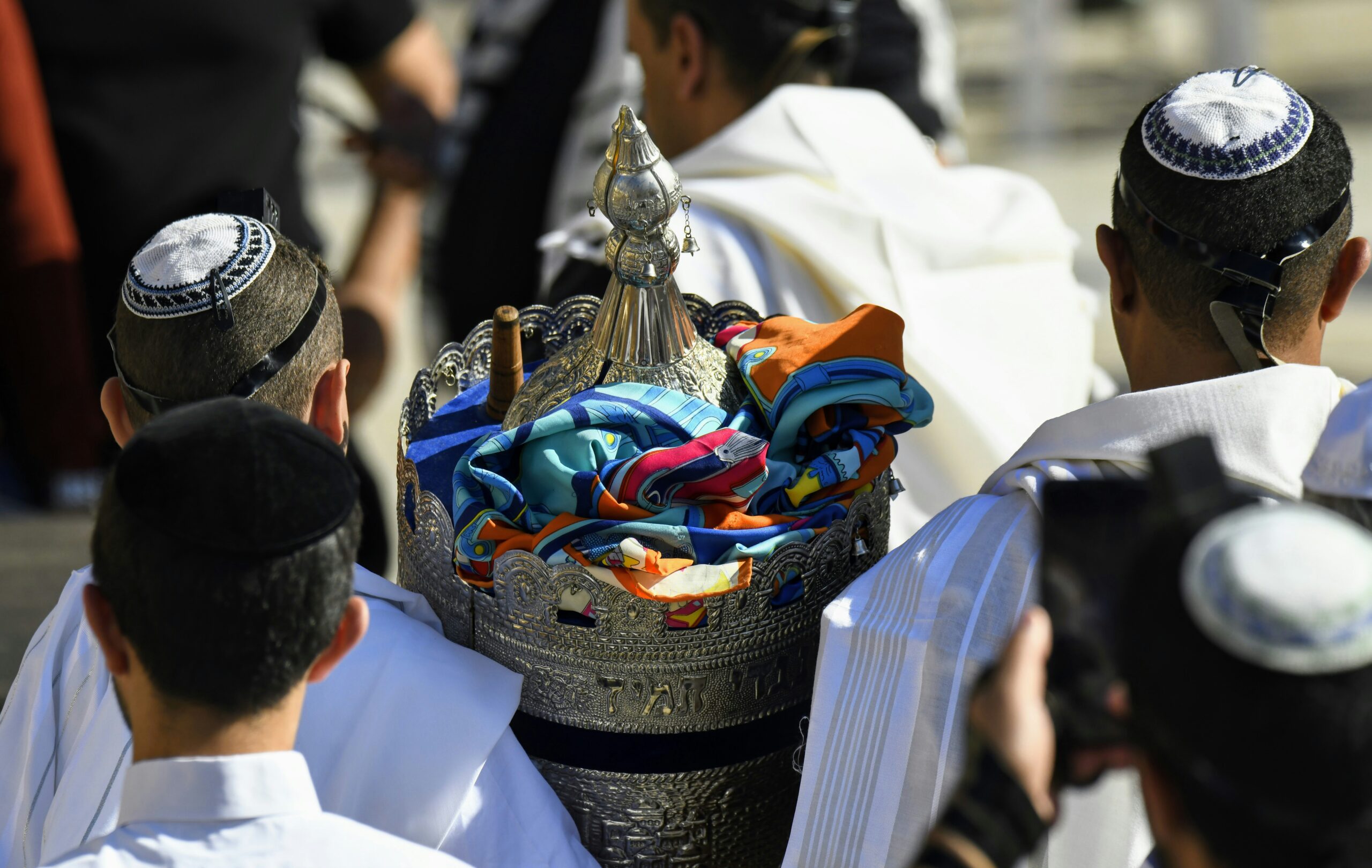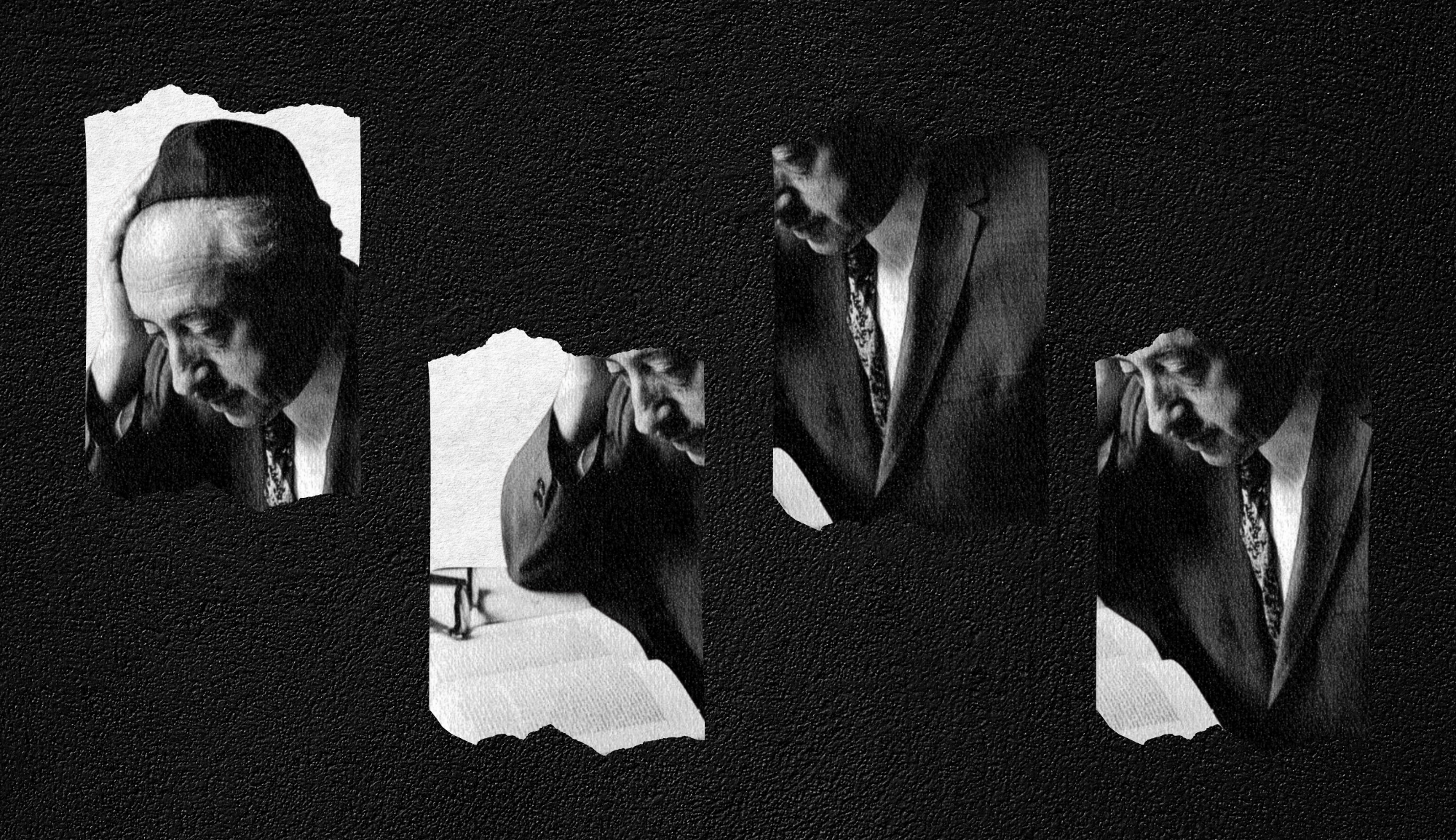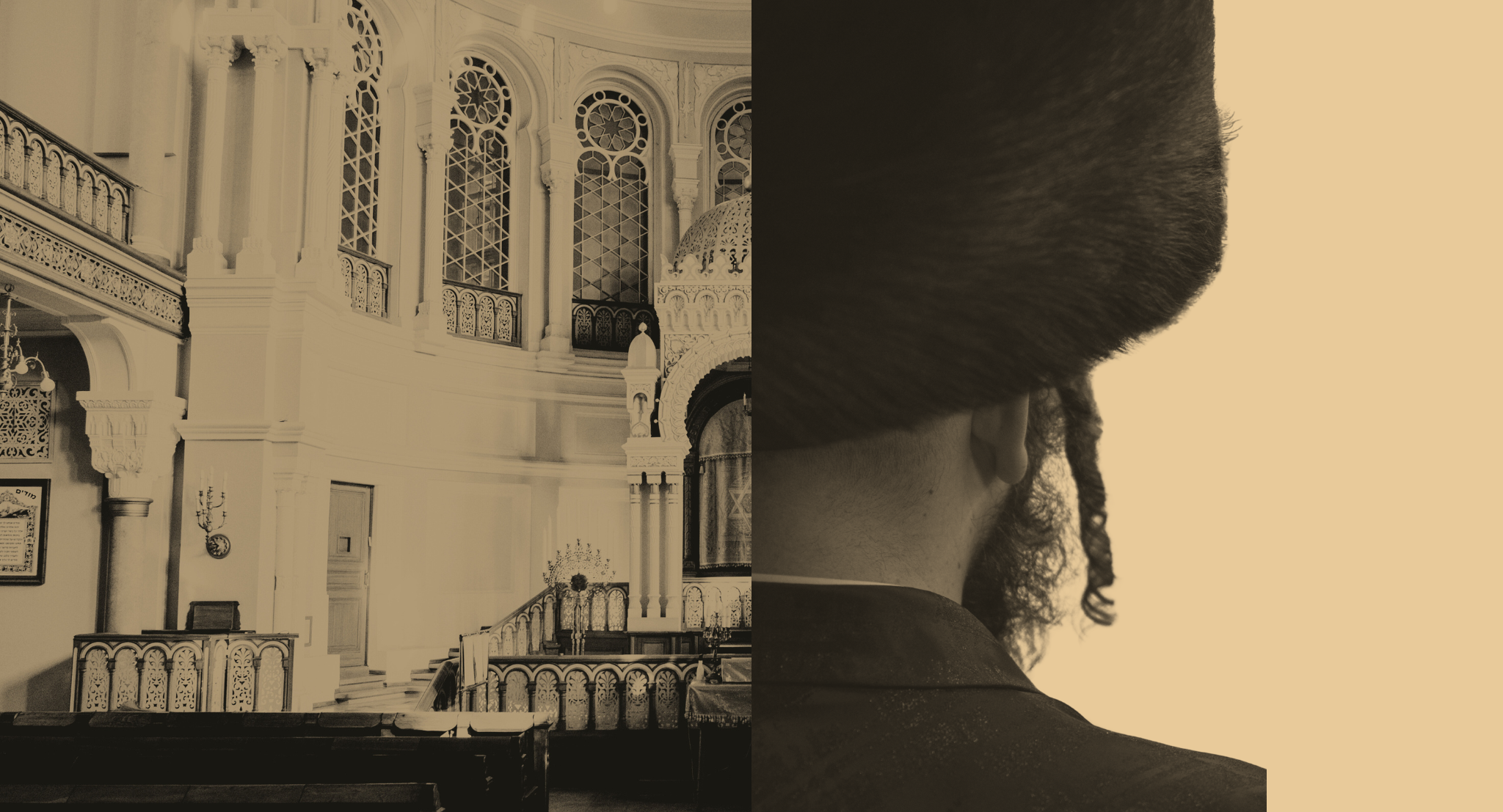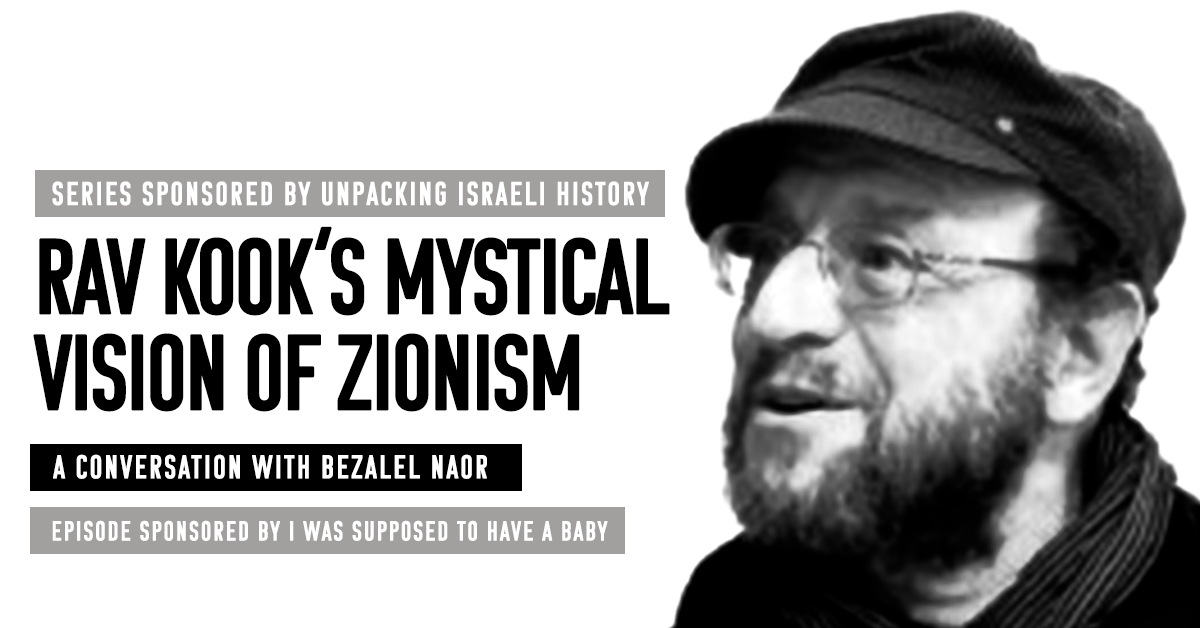
Summary
This series is sponsored by Unpacking Israeli History.
This week, we are sponsored by the Inaugural Global Jewish Fertility Support Summit, organized by the nonprofit I Was Supposed To Have A Baby. Taking place on Sunday, May 7th, via Zoom, this summit will include some of the most prominent voices from 15 major fertility organizations worldwide. Whether you’re on a fertility journey, a professional, clergy, or lay leader in the space, or if you want to know how to be more sensitive to your friends and family, this summit is for you! Learn more and register for FREE at iwassupposedtohaveababy.org.
In this episode of the 18Forty Podcast, we talk to Bezalel Naor—author, translator, and expert on Rabbi Abraham Isaac Kook—about Rav Kook’s relationship to the Land of Israel.
Rabbi Naor helps us see the bigger picture of the Zionist project by exploring the spiritual dimensions of Zionism as demonstrated in Rav Kook’s thought. In this episode we discuss:
- How did Rav Kook’s love for the Land of Israel begin?
- Where should one begin when learning the works of Rav Kook?
- What is the relationship between the nefesh, ruach, and neshama?
Tune in to hear a conversation about how the Land of Israel went from an abstract concept in the Jewish imagination to a concrete part of our lived reality.
Interview begins at 11:04.
Bezalel Naor is a teacher, translator, and author of many books on Rav Kook and Jewish mysticism. His works include Orot (Maggid, 2015); When God Becomes History: Historical Essays of Rabbi Abraham Isaac Hakohen Kook (Kodesh, 2016); The Koren Rav Kook Siddur (2017); and Navigating Worlds: Collected Essays (Kodesh, 2021), among other books.
References:
Navigating Worlds: Collected Essays (2006-2020) by Bezalel Naor
Orot by Abraham Isaac Hakohen Kook, translated by Bezalel Naor
Towards the Mystical Experience of Modernity: The Making of Rav Kook, 1865-1904 by Yehudah Mirsky
Rav Kook: Mystic in a Time of Revolution by Yehudah Mirsky
Rosh Milin: Kabbalistic Insights into the Hebrew Alphabet by Rav Kook
Igorot HaRaiyah, The Collected Letters of Rav Kook Volume Three by Rav Kook
Guide for the Perplexed by Maimonides
When God Becomes History: Historical Essays of Rabbi Abraham Isaac Hakohen Kook edited by Bezalel Naor
The Legends of Rabbah Bar Bar Hannah with the Commentary of Rabbi Abraham Isaac Hakohen Kook translated by by Bezalel Naor
Nine and a Half Mystics: The Kabbala Today by Herbert Weiner
The Souls of the World of Chaos by Rav Kook, translated by Bezalel Naor
Shemonah Kevatzim by Rav Kook
Transcript
David Bashevkin:
Hello and welcome to the 18Forty Podcast where each month we explore different topic balancing modern sensibilities with traditional sensitivities to give you new approaches to timeless Jewish ideas. I’m your host, David Bashevkin, and this month we’re exploring the topic of Zionism. Thank you so much to our series sponsor, Unpacking Israeli History. The Unpacking Israeli History podcast gives a fresh perspective on some of the most controversial and interesting events in the country’s history. Catch the current season now and don’t miss the special three part miniseries on the founding of the state of Israel. Listen to Unpacking Israeli History wherever you find podcasts, or follow the link in the show notes.
18Forty is part of a larger exploration of those big juicy Jewish ideas, so be sure to check out 18forty.org. That’s 18forty.org. You can also find videos, articles, and recommended readings.
I am so excited to present a special episode. We didn’t originally put this in our email on the series, and I was looking at what we were doing in our discussions of Zionism and I realized that there was something sorely missing in the discussion, and that is, at least to me on a very, very personal level, an exploration and introduction to the thought of Rav Kook on Zionism. I’m going to be completely honest, I have not really spent a lot of time on Rav Kook’s writing, but I feel incredibly connected to the thought of Rav Kook. It is something that whenever I listen or I hear, or the little bits and pieces that I’ve read that resonates in my soul in a very, very personal way. And I think people who know me, particularly people who see the way I interact online, and I shared this once, I think can appreciate why Rav Kook resonates and kind of animates so much of my thought.
I think it’s something that both people who enjoy what I do and people who absolutely hate what I do can appreciate that connection. And I think it’s because Rav Kook more than anything else, was really conciliatory. He tried to bridge opposites, he tried to find truth in opposing ideas and find goodness and holiness wherever he found it. Now, I obviously don’t embody even a droplet of the greatness of Rav Kook’s personality and writings. Even making a disclaimer on a podcast that, Hey, don’t confuse me for Rav Kook is absolutely absurd, but I feel like it always needs to be said.
He in many ways is my inspiration in the way that I look at the world. And there is one particular letter that really had a big impact on me. It is the 79th letter in his collected writings, and I’m just going to read for you. I’m going to be very brief in this introduction, but I want to read for you what he writes in this letter because it’s about how he looks at the world and how he looks at all of the fighting and dissonance that we find in the world. He writes in his files, I’m going to read it in Hebrew and then of course I’m going to translate. Klal gadol omer lchvodo.
I’m going to tell you a great principle. Shehashakafa hayoser meira binyanei emunah vedeaos. The more elevated, the more enlightened approach when it comes to looking at differences of opinion and differences of approaches to faith. Kimo bchol inyanim nisgavim. Like all lofty matters. Hi latzes mahchug hatzar. It is to leave our myopia. It is to leave our smallness. Shibo nimtza imshitos mechulakos. It’s in that smallness that we see all of this divisiveness, all of this argumentation. Hatzararos zu et zu levatlos elu es elu. These opinions that seem to be irreconcilable, that destroy one another, that pursue one another. The love and instead to approach to enter, ad marom haspiska, this elevated more supernal way of thinking. Shemisham nishkafos kol daos bishrasho. And it’s in that more transcendent world, that all opinions are rooted in, that all ideas are rooted in.
Eich shkulam olas lmakom echad. To realize that all of these differing approaches ultimately share the same source. Vrak shinoy tamaaim b’orchas hachaim. They’re just kind of different conditions and approaches in the way that they’re applied in everyday life. Ubimtzav hanefashos who hamechalek bayneihem. And is within the differentiation of the individual’s souls, they kind of the reality of different people’s life that they seem so divisive, but ultimately there is an underlying unity to the world and there is an underlying unity to what seemingly divides us.
And I think on all topics, certainly in Zionism, certainly when you go into Israel and you see so much fighting between different sections and sectors of the Jewish people, it’s hard not to hold on to this idea from Rav Kook, the notion that we need to leave, latzes mhachug hatzar, to leave our smallness, to leave our own myopia and some way, somehow lavo merom hapiska, to have some way of elevated thinking of not just to kind of be this partisan approach that this team is always right. Sometimes in the Jewish world, it feels like it’s a big game of color war, who’s right, who got the most points? And to try to look at the underlying values that everyone is negotiating with and that there is an underlying truth to everything.
Now, this approach works very well if you are a thinker and maybe more mystically inclined. It actually does not lend itself well to politics to say I see both sides, everyone is right, everyone has some truth to it, which is probably why I’m such a terrible politician and probably why I find the fighting and the battles of any area of politics, but particularly political Zionism, it’s so lost to me. I have a hard time staking a flag in one camp because I’m inspired and animated so much by Rav Kook’s thought in seeing that underlying truth that exists in each community.
There’s this amazing story that Rav Aton Henkin, hashem yikom damo, may his death be avenged, who unfortunately was killed in a terrorist attack, one of the great thinkers, and he has an article about an exchange between Rav Kook and his young student, Rav Hutner, following Rav Kook’s speech at the inauguration of Hebrew University. A little bit later, it was found out that in Hebrew University, they were going to be teaching biblical criticism and things that Rav Kook certainly did not approve of, things that would definitely question and erode people’s faith. And there’s an exchange, it’s said in different ways, but essentially Rav Hutner said with a little bit of a sharpness that was characteristic of all the things that he said, he kind of chided maybe in a way his Rebbe, Rav Kook and said that you Rabbi Rav Kook are able to see the shoresh of everyone’s neshama.
You’re able to see the roots of everyone’s soul, but because of that, it sometimes distracts from where their actual legs are standing. Sometimes, when you focus so much on the underlying unity of everything, you can pay less attention to where people are actually standing. And I think it’s that very tension that I struggle with in my own life. I definitely veer sometimes too far to looking at the shoresh, the underlying holiness that animates our lives. And you could sometimes get distracted from where their legs are actually planted. But I still remain deeply moved whenever I read Rav Kook and I was thinking we can’t talk about this topic at least without exploring, mentioning and just reminding people about the enduring relevance of Rav Kook’s thought. I think particularly in this modern world that we live in, in this divisive world we live in, his thought is so, so important.
And that is why I was so appreciative of Rav Bezalel Naor, almost an enigmatic figure. I didn’t appreciate his brilliance and his greatness. I had always thought that he was a translator, which probably is even a double mistake because to be a translator might be the most gifted and most elevated form of Jewish thought, to be able to present ideas in translation. Something that my dear friend Rav Joey Rosenfeld sensitized me to on his academia page. Academia is this website that houses people’s articles, and on Joey Rosenthal’s academia page, he labels himself, what is his profession? He says, “I’m a translator”. And the loftiness of being able to translate ideas from one language to another, from one set of thinking to another may be the loftiest thing that somebody is able to do. But I thought, okay, he takes things from Hebrew and writes them in English and I read a book of his over Pesach, Navigating Worlds.
He has so many books and we’re going to try to link to many if not all of them, and allow people to explore his work on Rav Kook. But I was floored. I was floored. I went through all of the footnotes, really, really jaw dropping, his command of such a breadth of writing in mysticism, in traditional works. He is a… I don’t know if this is an insulting word, but it’s a word I love. He’s a desultory thinker, he’s a wandering thinker. His mind wanders from topic to topic, from tangent to tangent. He’s not a sequential thinker in that way. He’s not laying it out like a textbook, but there’s something very free thinking, free flowing, very poetic, both about Rav Kook’s writing, but I’m talking about the way Rav Bezalel Naor thinks. And it was really a privilege and pleasure to be able to speak with him.
And just as a quick note, it comes up in the interview, something that was particularly heartening is that when I first reached out to him and connected to him, I mentioned that my grandfather, I don’t know why he came up, but I mentioned my grandfather, Rabbi Brykski of Moshe Brykski and he stopped me and pauses. “Was he a Rav in Portland, Maine?” And I said, “Yeah, how on earth did you know that?” And he said, “I’m from Bangor, Maine.” And I was absolutely floored and he told me two incredible stories about him and interactions with my grandfather, one involving one of my favorite figures, Rav Kasher of Menachem Mendel Kasher. That’s for a different time. But I found like we were two people who should have already been connected, finally meeting. Being able to have a discussion with him was really an absolute privilege.
He’s a world renowned expert in Rav Kook, somebody who brought Rav Kook’s writing both in Hebrew and in English, of the first to really bring his writing to a broader audience, which is why it is my absolute pleasure to introduce our conversation with Rav Bezalel Naor. I wanted to begin our interview with a letter that I have no doubt that you are familiar with, that was written in 1921 by the third Gerrer Rebbe, the Imrei Emet. He spent time in Israel in 1921 and met with Rav Kook. And afterward in a letter that he wrote afterwards about his impressions, he was writing in Hebrew, but he wrote as follows, talking about Rav Kook, he says:
Ulam, However, ahavaso et tzion, his love of Zion, overes kol gvul, breaks and almost transgresses all boundaries. Vomer al tameh tahor. And he declares that which is impure to be pure. Umarlo panim kioso shamru chazal. And he basically looks out and interprets and sees things that should be impure and looks at them as pure. And I wanted to begin with the criticism of Rav Kook before we even get to what it means to us today. Why do you think Rav Kook was such a recipient? We were so targeted on the criticism of the way he related to Zionism. What do you think he meant by it and do you think there is anything correct in the assessment that his love of Zion, ahavato litzio overes kol gvul breaks all boundaries?
Bezalel Naor:
Yeah, I’m very familiar with the letter. I published it in the introduction to a rote that I brought out. It was written from a ship on the way back from Israel to Europe and the Gerrer Rebbe compares Rav Kook to Rebbe Meir.
David Bashevkin:
The tanna, the figure from the Mishnah
Bezalel Naor:
And gets into the gemara in eruvin
David Bashevkin:
Exactly-
Bezalel Naor:
That as great as Rabbi Meir was, his contemporaries could not follow his thinking. And I discussed the letter, as I said in the introduction to O Wrote, Rav Kook might actually been flattered that he was compared to Rabbi Meir. I don’t know whether the Imrei Emes, Rav Avraham Mordechai Alter, was a baal ruach hakodesh, he might have been, but it’s as if he read Rav Kook’s root of his soul because Rav Kook himself, as I’ve pointed out in other writings of mine, identified very much with Rabbi Meir. So that was very on target on the part of the third Gerrer Rebbe.
David Bashevkin:
Can you explain more why Rav Kook compared himself to Rabbi Meir, and why do you think it was a propos and perhaps even flattering that he compared him to somebody who the Talmud describes as somebody who he never really got to figure out what he meant. We never fully comprehended what he was trying to say. Why do you think that would be a compliment and what do you think we should make of that?
Bezalel Naor:
Rabbi Meir was saying things that the rest of us don’t say. He was a love liar, he was a sofer and Bereshis Raba, it says, btorato shel rebbi meir there was in the Torah scroll, written by the hand of Rabbi Meir, there was a significant deviation where we have tov meod bereishis. He had tov mavet.
David Bashevkin:
That death is good. I just want to translate, that death so to speak is good.
Bezalel Naor:
That’s right. So you’re getting this amazing, theodicy. I’m using some jargon, some technical philosophical jargon. You have this amazing theodicy. This tzuduk hadin where Rabbi Meir is able to see the good in death, which is no mean feat. And Rav Kook has this ability to tov roey. He’s able to see goods where other people see evil. He’s able to see light where other people see darkness. And one of his writings, and there’s so many, and I don’t want to belabor the points, I’m not going to-
David Bashevkin:
Free to belabor, feel free to belabor. I want to understand the world of Rav Kook as you see it and understand it.
Bezalel Naor:
Yeah, Rav Kook is a whole world. His literary oeuvre is so voluminous and we haven’t seen all of it yet. In one of his many writings, he quotes the Zohar that Mashiach has this ability to transform darkness into light and bitterness into sweetness. And Rav Kook is a futurist. Of course as all of us, he’s confined to the present, but his vision extends into the future. It’s a very optimistic future. People ask me, did Rav Kook think he was the Mashiach? Did his followers think he was the Mashiach? And I don’t think so, but he definitely felt that he is privy to this, what he calls the oro shel mashiach. That’s a recurring theme in the book O Wrote, you get this phrase, oro shel mashiach, the light of Mashiach. So he thinks that he can see into a messianic future that most others are not privy to. So he probably was highly flattered with what the Gerrer wrote, which might not have been intended as flattery, but it’s like he read the shoresh haneshama, the root of the soul of Rav Kook. This is Rabbi Meir.
David Bashevkin:
What’s so interesting to me is that this is in 1921. This is before, maybe we’ll get to this, Rav Kook’s famous eulogy for Hertzl, which got a lot of attention both within the secular world and in the religious world that was seemed to be very transgressive to eulogize somebody who themselves was not observant in the way that he eulogized him. What do you think in 1921 gave away Rav Kook’s love for Zion? His ahavaso et tzion overes al kol gvul. How do you think this was manifest at that point in his career and in his life?
Bezalel Naor:
Let me read to you something.
David Bashevkin:
Please.
Bezalel Naor:
This is something that Rav Kook’s son, Zvi Yehuda Kook, who was my teacher. Baruch Hashem, I had the zechus , I had many private one-on-one sessions with him. This is Rav Zvi Yehuda Kook writing from Albstadt, Germany, Motzei Shabbat in 1914 and Rav Zvi Yehuda had left Israel. He was in Albstadt, Germany and this is what he writes. I’m translating from the Hebrew.
Regarding my father, there is a difference of opinion between the Zionists and their Orthodox opponents here as to which camp he belongs. To my questioners, I responded that when it comes to the rebirth of the land and the sacred tongue and in general our national establishment, we are with the Zionists. And when it comes to the destruction of Judaism, the throwing off of Toran commandments and the gentilization of education and lifestyle through the work of the Zionists, we fight with the might of opposition and concerted action. This is a very good statement of Rav Abraham Isaac Kook. His son has summed up very well where Rav Kook stands. So he sees eye to eye with the Zionist establishment when it comes to rebuilding the land, the language, and working for the political independence and sovereignty of what would become a united Israel. But when it comes to tearing down Judaism, what he calls gentilization, they do not see eye to eye and Rav Kook would fight bitterly, put up very stiff opposition.
David Bashevkin:
I wanted to ask you about kind of Rav Kook’s initial falling in love and his alignment with Zionism and where you think that began. Rav Kook was born in the 1860s, I think you probably know the exact date.
Bezalel Naor:
1865.
David Bashevkin:
1865. And he was a student of the Netziv. He learned in Volozhin. Where do you think Rav Kook first fell in love and first like the mythical figure of Rav Kook that we know now that is adored and associated with the religious Zionist movement? Where do you think that Rav Kook was first born?
Bezalel Naor:
I recently reviewed Yehudah Mirsky’s book, it was originally his doctoral dissertation.
David Bashevkin:
Towards the Mystical Experience of Modernity, the Making of Rav Kook. I’m looking at it right now. It was published by Academic Studies Press and he has a second biography by Yale, which is a little bit more digestible, from their Jewish Lives series.
Bezalel Naor:
At first he published in the Yale Jewish Life series, which spans the entire lifetime of Rav Kook. But what has come out recently by Academic Press in Boston is a refurbished doctoral dissertation of the first 39 years of Rav Kook. That’s 1865, when he’s born of course, and it takes you up to 1904 when he assumes the Rabbinate of Yafo, Jaffa. And I reviewed Mirsky’s book and one of the things that Professor Mirsky shows is that in this early phase of Kook’s life, practically the first 40 years, he lived to be 70. So the first four decades of his life, you don’t see in his writings a fixation on Eretz Yisroel. He may talk about it, as does every rabbi, right? Every rabbi speaks about Israel. There doesn’t seem to be this fixation, this fascination with Eretz Yisroel that we see in the later writings.
That’s a surprise for many of us and comes as a shock to many of us. I speculated, well first of all, I quoted something mystical, which I learned from my teacher, Rav Spuda. It’s a passage in the Chessed l’Avraham by one of the great Jewish mystics that’s Rav Avraham Azouli who says that the first night of your Aliyah, you know when the Jew makes Aliyah to Israel, you pick yourself up and move to Israel. The first night, your old neshama of chutz lareretz leaves you and there descends a new neshama. And when you wake up in the morning, you have a new neshama of eretz yisroel. If you’re a Kabbalist, you will take that literally, I suppose. But it can be taken figuratively.
Something happens to Rav Kook when he arrives in Yafo and there begins this great love affair, this great romance with Israel. The Gerrer Rebbe says that it was too much. It was overly romantic. So that’s one of the transformations. There’s another interesting transformation that could go hand in hand with that. And that’s the exposure to Breslov Hasidics. Does not come into Rav Kook’s orbit in Europe. In Japho, he is exposed to Breslov Hasidics.
David Bashevkin:
Through who?
Bezalel Naor:
Well, that’s a good question. The Breslovers say that it was by one of their great Manhegim, probably the greatest at that time, Rav Avram Nachman, he was the one who introduced Rav Kook to Breslov chassidus. My teacher, Rav Zvilda was a closet Breslover. I don’t know if you’re aware of that.
David Bashevkin:
And why do you think Rabbi Nachman’s writing had an effect on his love for Israel?
Bezalel Naor:
Oh, Rabbi Nachman has a tremendous love of Israel. There are some very interesting statements about Israel made by Rabbi Nachman. One of the statements goes like this, “You might think when I talk about Israel, I’m talking about something metaphysical and spiritual and no, no, no, I’m referring to these houses.” He says in Yiddish, “these houses, these buildings. So don’t get the wrong idea, when I speak in this impassioned tone about Israel, you see them. You might think I’m talking about the olamos elyonim.
David Bashevkin:
Supernal world.
Bezalel Naor:
Yes.
David Bashevkin:
The reality of Israel is where he found holiness.
Bezalel Naor:
That’s it. Now, I’m going to segue. I’m known to do that.
David Bashevkin:
Please.
Bezalel Naor:
You spoke about Ger. So one of the great men I had the privilege of meeting this lifetime was the son of the Imrei Emes. His name was Pinchas Menachem Alter. Originally, he was the rosh yeshiva of Sfas Emes. Later he becomes the Gerrer Rebbe, the Menachem. He wasn’t only a Hasidic rebbe, he was a great Torah scholar. That’s what Ger is really all about. In fact, Rab Suda once told me that when it comes to chassidim yesh viyesh meaning, there are some that are Torah scholars and some that are not Torah scholars. But he singled out for honorable mention, Chabad and Ger. He said they’re bnei torah. He said some of the other groups may not have been such great Torah’s, but Lubavich and Ger, they knew how to learn.
And Pnei Menachem’s son is Rab Shaul Alter. I’m sure you know quite a bit about Rab Shaul Alter. So he continues his father’s tradition of being a phenomenal, a Torah genius. Anyway, I’m going to share with you something I heard from the Pnei Menachem. I went to be Menachem of the Boston Rebbe in Har Nof. His name was Levi Yitzchak halevi Horowitz. I’m from New England, spent a lot of time in Boston. The Bostoner lost his older brother, Rav Moshe Horowitz, who was the Bostoner in Brooklyn. And I went to be menachem for the Bostoner. It was in the afternoon. It was a strange hour. There were very few there. We could count them on five fingers. If you want afterwards, I’ll tell you who was there. But the most distinguished was the Pnei Menachem. He wasn’t yet the Rebbe, he was the rosh yeshiva. And the discussion was all about Eretz Yisroel.
And the Gerrers, they’re excitable, they’re passionate, they can raise their voice. They raised their tone, the decibels. I’m sitting there and opposite me is Pinchas Menachem Alter. And he made a statement. The whole conversation was in Ivrit by the way, not in Yiddish, which was good for me because my Yiddish is weak. My Hebrew is much stronger. And I’ll translate what he said. He said, “When the Ramban, who’s a great Bible commentary, Rav Moshe ben Nachman, when the Ramban speaks about Eretz Yisrael, Ze Lo allegoria. It’s not an allegory.” And I was amazed. How does he know the word allegory? It’s like I’m listening to a professor from a Hebrew University. But he was a very broad-minded individual when you got to know him.
He said, Ze Lo Allegoria. When the Ramban speaks about the sanctity, the holiness of Israel, and that all of the mitzvahs, the belong to eretz Israel and that whatever we do in chutz laretz is just going through the motions. But the real mitzvahs, the real performance of the commandments, it’s not an allegory.” And then he gave a bang and he said, “Mamish”. It’s reality.
David Bashevkin:
Wow.
Bezalel Naor:
So you could hear in that that whatever you’re reading in his father’s letter about Rav Kook, the truth is, the truth known to both the Gerrer Hasida and to the Hasida of Kook, there was a great love between the Gerrer, Rebbe the Imrei Emes and Rav Kook. And I could tell you so many stories about the love between the two men.
David Bashevkin:
Allow me to introduce one other variable and we’ll move a along when Rav Kook’s life. But I want to fast-forward a little bit, not to Rav Kook the one that we know today. But the Rav Kook that often gets overlooked is the period during World War I, when Rav Kook gets stranded outside of Israel. This is after he was the Rav of Yafo, before he has elected the Chief Rabbi of Israel and he is stranded and becomes a Rav in London. And I think for many of our listeners, particularly those who don’t have the opportunity to live inside of Eretz Yisroel, much like myself, I’m curious, what do you think we could learn from the period in Rav Kook’s life? This is after he’s exposed to the beauty of Israel. This is after the romance has already begun and he’s forced now, he’s blocked out of going back to Israel, and he’s forced to live outside of Israel. What do you think we can learn about Rav Kook’s relationship to Israel, Rav Kook’s love for Israel, from the period that he was forced to spend outside of Israel?
Bezalel Naor:
He was always very connected to it, even when he was in exile. First, he spends at least a year in St. Gallen, Switzerland. He had no Rabbonis there. He was the house guest of Rav Avraham Kimchi who had rachmonis on him and took him in and set him up in his home. From Switzerland, he becomes the Rav of the Machzike Hadath, in London’s east end. It was a congregation of East European immigrants. He always felt connected to Israel. There was always tremendous galguim, nostalgia, I guess would be the word, longing. And he was always working for Israel. And it really was fortuitous that he was in London at that time because he was there during the Balfour Declaration and he militated for that. In fact, there was the session of the British Parliament. There were Jews in London who were opposed to the Balfour Declaration.
There was a fellow by the name of Montagu, M O N T A G U. And others who for whatever reason thought it’s a very bad idea. They were opposed to what the Zionists were doing. You had Chaim Weizmann and Nahum Sokolow who got Lord James Balfour on board. In one of the sessions of parliament, one of the MPs asked the rhetorical question, “Who knows what’s better for the Jewish people? Lord Montague or Rabbi Kook?” He really had input into that process. Behind the scenes, Rav Kook was militating for this Balfour Declaration. And I guess that’s something that we should try to apply. If we are living in Chutz Laretz we should always be connected to Israel.
This acute anecdote about Rav Hutner, Rabbi Yitzchak Hutner, who was a disciple of Rav Kook in Jerusalem when Rav Hutner was a young man, and Rav Hutner said that he always saw himself as Ben Eretz Yisroel, even though he was living in Brooklyn. And he rose to fame as Yeshiva of Chaim Berlin and today it’s in Coney Island Avenue and the Flatbush section of Brooklyn. But he said, “I always viewed myself as an ambassador from Israel, who will one day return to my home”, which he did. The end of his journey, Rav Hutner settled back in Yerushalayim.
David Bashevkin:
Rechov Hakablan
Bezalel Naor:
The other thing is not only to feel connected as well, but we should all be activists. We should all be working. I don’t know if behind the scenes, in front of the scenes, working for the good of Israel.
David Bashevkin:
You think there’s anything to be gleaned from what he was writing and what works he spent time on, specifically during his time outside of Israel when he was fleeing? Meaning what was occupying his written time, what Torah he was being drawn to?
Bezalel Naor:
I heard from my teacher, Rav Tzvi Yehuda that in London, this would be 1917, his father Rav Avraham Yitzchak received a ksav, that was Rasvuda’s exact word, which I questioned and he repeated it again. Make sure I got it. It is a command, a mandate.
David Bashevkin:
A mandate?
Bezalel Naor:
Yeah.
David Bashevkin:
Okay. From who? Who did he receive this from?
Bezalel Naor:
A mystical command. From-
David Bashevkin:
A heavenly command. Okay.
Bezalel Naor:
He was commanded to bring out two works. One, Rosh Milin, I don’t know if you’re familiar with that.
David Bashevkin:
I sure am. I’m fascinated by it.
Bezalel Naor:
It’s a mystical work. It’s Rav Kook’s own midrash haotiot his own Midrash.
David Bashevkin:
On the letters of the aleph-bet. It goes letter by letter starting aleph, bet, gimmel and talking about the mystical significance of each letter in the aleph-bet. What you’re saying is you heard from his son that he got a almost divine mandate.
Bezalel Naor:
Yeah, yeah.
David Bashevkin:
That his father, Rav Kook, who we’re speaking about, got a divine mandate to what, to explore the aleph-bet?
Bezalel Naor:
To write this work. Now someone who was a helmut of Rav Kook in London wrote that that whole sefer, Rosh Milin was produced in under a week. So it sounds like there was some kind of inspiration where he brought out this whole sefer in under a week. The other work that he was mandated to produce was the Halacha Berura This is a very prosaic halachic work where Rav Kook jotted down in the margins of his copy of the Talmud, the Halachic decisions, the piski dinim of the Rambam and Shulchan Aruch. He did it from memory. He had a phenomenal memory. And afterwards, the editors checked and they found out that it was pretty much perfect. In a few places it was off, but quite amazing to have all of that in your Keppele. The entire compound, the entire Shulchan Aruch you write in the margins, the upshot.
The reason Rav Suda shared this with me was this was our first impactful meeting. I’m not going to go into it. I was very young in my early twenties. I was newlywed and I’m meeting Rav Suda for the first time in his home, and he offered me to work on this project, which is an ongoing project. The talmidei Mirkaz Harav, they do this. Rav Aryeh Stern was the head of it for a while. And I guess in order to entice me to work on this, he said, “In London my father got its”, and he said to me, the same tsavah, the same command that told my father to write the Rosh Milin, told him to write Halacha Berurah. So that’s how he tried to entice me because he figured out that I’m a Reish Milin enthusiast and he’ll tell me that the other work is coming from that same level of inspiration, so I should get to work on it. But I politely demurred because frankly it did not hold out to me the same allure as Resh Milin.
David Bashevkin:
I understand that.
Bezalel Naor:
Eventually, some years later, I wrote on Reish Milin, which were published in Sinai. I was the first one, and since then others have written commentaries on Reish Milin. Well actually, Chaim Yaakov Levin, Aryeh Levin’s son did some work on Rosh. He was a Talmid of Rav Kook, also for Baruch Ber. It was published in Jeshurun, a couple of years ago. But I’m talking about published work. So Chaim Yaakov Levin had a manuscript, which during his lifetime was never published, but I was the first one to publish commentary on Reish Milin. And since then, others have… I was the national and others have died since then. So we have a man living in London in exile from his home. His home was Japho. He’s living in exile and he’s working on two projects. Now, the first one I understand, Rosh Milin, because at times of crisis, and this is World War I, London was being bombed. So we know at times of crisis, people turn to mysticism.
That’s when people turn to Kabbalah. So I understand why he’s working on Rosh Milin. And by the way, his Talmid Muvhak Rav Yaakov Moshe Charlap, back in Yerushalayim wrote that the only way his Rebbe could have come out with such a work of mysticism in London. He said that there had to be a Tzinur. There had to be a pipeline from the kodesh kedashim in Yerushalayim all the way to Rav Kook’s residence in London. So that I understand, as I said, at times of crisis, people are looking for answers. They turn to mysticism. The other project, the Halacha Berurah is difficult for me to understand. I don’t understand that. It seems out of sync.
David Bashevkin:
I understand your question, meaning the Rosh Milin, I understand and I knew that was from that time and I wanted you to speak about it, because it’s almost like getting back to the essentials, getting back to the basics and that mystical underpinning of reality itself, which when the world is being turned upside down, to write a mystical work on the alaph-bet, as fascinating as it is, it also makes a certain degree of sense. If you understand the personality of Kook and the personality of mysticism itself, do you really not know, or do you have maybe an inkling of a thought for why he was so attracted to also write Halacha Berurah this more cut and dry Halakhic work during this period.
Bezalel Naor:
It could have been a continuation of what he was attempting that decade in Yapho. Rav Kook, as I said, he arrives in Yapho, 1904, he set sail for Europe in 1914 to attend the Keneseya Gedola at the invitation of Moreinu Rav Yaakov Rosenheim, which is highly ironic.
David Bashevkin:
Aguda.
Bezalel Naor:
The aguda, right. But at that time, Rav Kook was on very good terms with the aguda. The falling out comes later. So in that decade from 1904 to 1914, Rav Kook grabbed the hold of the most promising young Torah scholars in Jerusalem. One we mentioned, Yaakov Moshe Charlap and another was Tzvi Pesach Fran, introduced Rav Charlap to Rav Kook. And another one was Rav Yisroel Porat, who in the United States became the chief Rabbi of Cleveland. These were budding Torah scholars, young men who came under Rav Kook’s wing in Yafo. And Rav Kook is already thinking in terms of a new derech halimud for the chachmei eretz yisroel.
David Bashevkin:
A new approach to Torah learning.
Bezalel Naor:
Yeah, a new methodology. We’re not going to be learning Torah the way we did back in Europe. And he publishes things along these lines that the chachmei eretz yisroel can’t just be imitators imitating the East European style of learning. They’re called upon to produce a new method of studying Torah. So I think he was already starting to think along such lines. And I guess this ksav, as my teacher called it, was the Makeh Bpatish to come out with the halacha berurah.
David Bashevkin:
It was the final strike that allowed him to kind of begin this methodology in clearing a path to almost a clearer path in Talmud study, which really marks a lot of what halacha berurah is about. It’s not really as concerned or as occupied with some of the lumdus finer distinctions and fancy analysis. It’s almost like a clearer paved path to approach the Talmud with.
Bezalel Naor:
Yeah. I’m going to share with you another anecdote which shares out what we’re saying. One of the great European Rosh Yeshiva was Rav Shimon Shkop and he very much wanted to become the Rosh Yeshiva of Merkaz Harav. That was the Yeshiva that Rav Kook created in the 1920s. When he comes back from London, Rav Kook creates a few institutions. One is the chief Rabbinate . Another institution he created was Mercaz HaRav and Rav Shimon Shkop very much wanted to become the Rosh Yeshiva of Mercaz HaRav. The first Rosh Yashiva was the Tavrika. That’s Avraham Hakohen Borstein, who died at the age 59. He lasted one year. He was the first Rosh Yashiva of Mercaz HaRav. They call him the Tavrega. He came from a town in Tavreg, phenomenal Torah genius. But then it was pretty much up for grabs. Who would be the next Rosh Yeshiva? and Rav Shimon Shkop wanted in, and he was rebuffed. And the one who had to rebuff him was Rav Yaakov Moshe Charlap, who writes a letter and it’s published. Yeshiva University published for my dear friend, Rav Zevulin Charlap.
David Bashevkin:
Zebed Tov.
Bezalel Naor:
Oh, Zebed Tov.
David Bashevkin:
Well, I read your book and I saw this in a footnote. It was one of the things that really caught my eye that you had read Zebed Tov. It was edited by a friend of mine, name of Ari Zatz who was affiliated with Bnei Yeshurunin Teaneck, and married a close friend of my sister, Michal Gelibter. And I saw you reference this letter. Tell me, what did that letter say that you found so fascinating?
Bezalel Naor:
Rav Charlap tells Rav Shimon Shkop, don’t importune anymore. Give it up. And he says, I spoke to the Rav and what I’m telling you comes from the Rav. So this is final because Rav Shimon Shkop was trying to importune through various Talmidim. One was Rabzeb Vine, that’s Rav Berel Wein’s father. And Rav Charlap says, “So listen, what I’m going to tell you now comes from the Rav. This is final. The Rav does not want your Derech halimud, Rav Shimon Shkop had put together a methodology of Hasbarah and Rav Kook doesn’t want this for his Yeshiva. Rav Kook wants to get back to the derech Halimud of the Gra a. And Rav Kook, in fact wrote a super commentary on the beur hagra to choshen mishpat . And that’s what he wants for his Yeshiva. If we can capture the derech halimud of the vilna gaon. Which is Peshat.
David Bashevkin:
The basic meaning of the text.
Bezalel Naor:
Yeah.
David Bashevkin:
Do you think that’s connect to Rav Kook’s approach to Eretz Yisroel itself? Do you think this methodology that he emphasized so much was connected to his philosophy about Israel?
Bezalel Naor:
Yeah. I see you have in your Sefer, you have a long letter from Rabbi Bergman. He can set you straight on why Rav Kook’s take of the Yerushalmi is all wrong because David Hallvni Weiss, who’s Ari Bergman’s brother in Talmud methodology came out with this notion of the Stamai. And that’s what you’re getting in the Bavli and you don’t have in the Yerushalmi, but Rav Kook didn’t know from David Halivni Weiss and Ari Bergman and Stama Inn, so Rav Kook, who was given to romanticization as the Gerrer pointed out, he romanticized Eretz Yisroel. He romanticized Am Israel. He romanticized also Talmud Yerushalmi. So there’s a letter of Rav Kook to the Baal Dorot Harishonim, which was Ari Bergman’s first love. That’s Isaac Helavi.
David Bashevkin:
Another Agudist.
Bezalel Naor:
Who was a Litvak, who goes to Germany, and he writes a multi volume historical. So Rav Kook writes to the Baal Dorot Harishonim how he sees the difference between the Jerusalem Talmud and the Babylonian Talmud. And he says in Babylonia, they were bereft of Ruach Hakodesh. They didn’t have divine inspiration. They had to use their Keppelach, the gray matter. They didn’t have the gift of prophecy, but in Eretz Yisroel, they no longer had Nevuah, but they still enjoyed the gift of Ruach Hakodesh. So Kook says that’s why if you compare a sugya a talmudic discussion, discussion of the Yerushalmi to the parallel of the Bavli, you’ll see that the Bavli’s discussion goes on much longer. It’s more convoluted, it’s more Kabbalistic. And the Yerushalmi is curt and sharp. Why? Because they didn’t have to break their heads. They had the ksav.
David Bashevkin:
The divine mandate to see through all of the weeds and thickets and forests.
Bezalel Naor:
They had the beam.
David Bashevkin:
They had the beam
Bezalel Naor:
Beam of light, the shaft of light. So what the modern scholars will tell you is that that’s very beautiful Rav Kook, but that does not truly account for the differential. The differential is what I was saying before, these stamaim. Well, the Yerushalmi signs off earlier.
David Bashevkin:
Yes, the riff mentions that at the end of Aruvin. I was wondering, one of the issues that I have had with studying Rav Kook is I don’t know where to begin. I have spent much of my life studying the works of Rav Zadok ha-Kohen of Lublin, who listeners to 1840 have heard many, many times me speak about him. And I feel like I have a better understanding of where to start. He also has many, many volumes of writings, but it’s easier to navigate just like where to begin. I have an easier time finding a way around it. I find that Rav Kook’s writing, it’s hard to know where to lift it up from, where to begin, how to get those primary ideas. And I think for our listeners, it would be so helpful if you could share, somebody who has never studied the works of Rav Kook. Where do you suggest people to begin?
Bezalel Naor:
Well, I like Orot.
David Bashevkin:
And just start right in the beginning?
Bezalel Naor:
Yeah. Orot is a seminal work of Rav Kook. It comes out in Yerushalayim in 1920. It arouses great controversy.
David Bashevkin:
What’s the controversy around Orot? What are the passages in Orot that provoked controversy?
Bezalel Naor:
In fact, the Gerrer Rebbe Imrei Emmet comes from Poland to Israel to make peace between Rav Kook and the opposing camp under Rav Chaim Zonnenfeld. But what ignited this powder keg? It was the sefer orot.
David Bashevkin:
What about it?
Bezalel Naor:
It was a very controversial work. The Kanaim as they called, the zealots felt that it’s treif pasul.
David Bashevkin:
Why? What could ever have given them that impression?
Bezalel Naor:
Well, we have to translate treif pasul into English.
David Bashevkin:
It was impure. It was not kosher. What possibly could have been not kosher in that work?
Bezalel Naor:
The two statements that riled people the most, that are a couple of them. If you read my introduction to my translation of Orot, you’ll get all of that there. But the two that riled them the most. One is Rav Kook says that in exile we Jews, we neglected what he calls kedushat haguf, which is a term out of seder kodashim.
David Bashevkin:
The holiness of the body.
Bezalel Naor:
But he means the human body.
David Bashevkin:
Correct.
Bezalel Naor:
And he says, kedushas Haguf. We were overly cerebral and we didn’t tend to the holiness of the body and now in Eretz Yisroel, the young people, they’re doing hitamlut, they’re doing physical exercise in their own way that’s on a par with the tehillim of David Hamelech. That’s very, is the word, conflagulatory?
David Bashevkin:
Incendiary.
Bezalel Naor:
Incendiary, okay. It produces a conflagration. Such a statement. Wow. So young Jews are doing hitamlut, they’re doing physical exercise. And that somehow on a par with David Hamelech. That was one statement. Another statement was we have three kinds of Jews, one kind of Jew who, they’re not religious, but they do for the land of Israel. They’re chalutzim, they’re building up the land. And then we have other Jews, shalumei emunai yisroel. They’re pious, but they’re very weak when it comes to rebuilding the land of Israel.
So here, Rav Kook references some Kabalistic psychology that there’s nefesh, ruach and neshamah. There are three levels of psychology of the psyche. So there’s nefesh, which is the lowest level, which is the body, and then there’s ruach and the highest level isneshamah. So he said, Look, these Jews that they’re not Shomer Shabbos, but they’re doing for the land. So they’re nefesh, that lower level. The physical level is, but the ruach leave something to be desired. And then the frumme yidden the shalumei emunai yisroel is developed, but their nefesh is very weak. And the ideal is those tzadikim, who are able to combine two together, and they’re the level of neshama. Anyway, as soon as you start to criticize the frum belt, you’re going to get into big trouble.
David Bashevkin:
I’ve come to learn that in my own life.
Bezalel Naor:
Okay. Tzadikei geumurim are gemurim, okay. One does not criticize them.
David Bashevkin:
The holy righteous should be treated as being wholly righteous.
Bezalel Naor:
Right. their geumurai, they’re complete. They have it all. And who does he think he is to start to criticize us? So Rav Kook started up with the right people, as they say. So that’s where you should start. You should start with my edition of Orot as a wonderful historical introduction. It’ll give you the backdrop and the translation. The Hebrew and the English are fas a fas. So there are people who tell me that they learned to understand Rav Kook’s Hebrew from my English translation because Rav Kook created his own language.
David Bashevkin:
It’s very challenging, his Hebrew.
Bezalel Naor:
Native Israeli speakers, some of them hook into Rav Kook’s Hebrew through my English translation, believe it or not.
David Bashevkin:
No, it’s a very challenging Hebrew.
Bezalel Naor:
His syntax is impossible. The sentences go on and on and on. And then there are some end notes.
David Bashevkin:
We’ve never met. We spoke once on the phone and I look at it because we established such a remarkable connection. You had mentioned that you were born and raised in Bangor, Maine, and you had recognized the name of my grandfather, Rav Mosha Bakriski. I don’t need to get into the remarkable story that you told me. My grandfather was a rabbi in Portland, Maine. There are a handful of Jews alive today who have even heard of my grandfather. So he had a very remarkable life, but I’m going to use our connection, our familial. I call us Lonsmen, we both hail from Maine. I want to use that connection to maybe ask a question that is a little bit more personal.
And it’s a two-part question. One is, I want to know what brought you to Rav Kook. You have a very unusual mind, a very gifted, a very synthesizing mind. I’ve only read one of your books, but I read every single footnote and I was floored. You don’t really see that all too often, where you were quoting from what you had at your command. You grew up in Bangor, Maine. You could have been drawn to a thousand different thinkers. I want to know what drew you to Rav Kook. And then I want to know why somebody who spent their entire life studying Rav Kook, how they justify or understand why they don’t live in Israel themselves.
Bezalel Naor:
I don’t want to speak to …
David Bashevkin:
You, personally. Okay.
Bezalel Naor:
Yeah. But to answer your question of how I came to Rav Kook, because I think this might help other people. I was not always a Kookian. In fact, as a teenager, I was drawn to Va-Yoel Moshe of Rabbi Joel Teitelbaum.
David Bashevkin:
The Satmar Rav.
Bezalel Naor:
That’s right. I had a not good picture of Rav Kook. I thought that he was a politician, not somebody that I was interested in. I have to be very careful what I say because Rav Kook is Kadosh. But I felt that he had accommodated the Zionists, that turned me off. There was one eyeopener along the way. When I was in the eighth grade, I had a Rebbe who was a Lubavitcher, and he said that Rav Kook was an adam gadol.
David Bashevkin:
A great man.
Bezalel Naor:
He was a great man. And that was an eyeopener. Until I heard that, for various reasons, I did not think highly of Rav Kook. Not somebody that I would look into his works at all. But when this one teacher of mine, whom I respected immensely, and he was not a Mizrahist. He wasn’t a kippa sruga. He didn’t have a knitted kippa. He was a full-fledged. Lubavitcher, someone very close to Lubavitcher. When he said that, I mentally filed that away that maybe I should reserve judgment. Maybe I don’t have the total picture. But I didn’t go anywhere with that. I was very much into Va-Yoel Moshe. I could probably have repeated it by heart. And in those days I knew it very well. And when I was around 20 years old, I had a crisis, like a breakdown. It’s not a midlife crisis, it’s a quarter life crisis, they call it.
David Bashevkin:
I had one such crisis in my twenties as well.
Bezalel Naor:
A quarter life, yeah.
David Bashevkin:
Yep. A very real one. Yes.
Bezalel Naor:
Okay, well be prepared for the next one. It’s called the midlife crisis. You ain’t seen nothing yet. And I was al parsha drachim, I had left yeshiva. I was not yet in university.
David Bashevkin:
Would you call it a crisis of faith? How would you describe the crisis?
Bezalel Naor:
I had been given to understand by whomever that there’s no place for someone like me in the yeshiva world, that what I’m striving for, which was I striving for? Well, I had three favorite sefarim in those days. One was Moreh Nevuchim. Second one was Tanya. The third one was Likutei Maran, also looked into Mara. Anyway, that what I was striving for, there really, there’s no place for it in yeshiva. Yeshiva is a place for Gefes. We studied Talmud.
David Bashevkin:
The classic.
Bezalel Naor:
And you want to do philosophy and Kabbalah, and this is not your place, but where is my place? So I told you about my eighth grade rabbi, the Lubavitcher Rosh. The next year, my rabbi was Rabbi Aharon Rakeffet. In those days, his name was Rothkoff, Aaron Rothkoff.
David Bashevkin:
Sure. I didn’t know that. Was this in Bangor, Maine?
Bezalel Naor:
No, no, no. In my life there’s been constant oscillation. So I went back and forth between Bangor and yeshivas in New York.
David Bashevkin:
I’m not going to translate that one.
Bezalel Naor:
The first time I left Bangor, I was 10 years old. There was no Yeshiva in Bangor. Later, it was a day school. Rabbi Isaacs made a day, like your grandfather made a day school in-
David Bashevkin:
Portland.
Bezalel Naor:
Portland, right. Isaacs made a day school in Bangor. But when I was growing up, there was no day school yet. So at age 10, I left Bangor to go to yeshiva, and I was there through ninth grade, at which time I came back, did three years in Bangor High School. After I graduate, I went back to yeshiva. And this is the story of my life. There’s polarity, constant oscillation between different poles of my being.
Anyway, the next year I had Rabbi Rakeffet, who’s a ardent religious Zionist, and when he saw how davok I was to the Va-Yoel Moshe, so he figured he would provide the antidote, which was Igorot HaRaiyah. So I came into possession of the three volumes of the letters of Rav Kook, but I never opened them because as I told you, I had such a negative image of the man that why would I even open his work? So now I’m about 20 years old and I left yeshiva, I’m back in Bangor. At this time, we spoke about times of crisis when you start looking for mysticism. So I would read anything at this point. I read Autobiography of the Yogi by Paramahansa Yogananda.
David Bashevkin:
You don’t have to translate this, you can just sing it out.
Bezalel Naor:
If you can read my Autobiography of the Yogi by Paramahansa Yogananda, you’ll open up the Zionist route basically.
David Bashevkin:
It can’t be any worse.
Bezalel Naor:
But in order to open up the Zionist Rabbi’s letters, I had to take a deep breath. I had to blow the dust, they were caked with dust. There was a layer of dust that thick on them.
David Bashevkin:
On top of the works.
Bezalel Naor:
So I had to take a deep breath and blow the dust off in order to open up the Zionist Rabbi’s letters. And I open up, oh my God, he’s speaking to me and I experienced a meltdown. It was such a catharsis.
David Bashevkin:
Do you remember what letter you opened up to?
Bezalel Naor:
People always ask me that. I do not remember the exact letter, but I can give you the drift of it.
David Bashevkin:
Tell me.
Bezalel Naor:
The drift goes like this. And again, you’re getting it filtered through my consciousness, but it goes like this. There are young Jews who unfortunately are turned off to Judaism. They’re disenchanted. And why?
Because what do we present them with? We present them with the Torah, which is so dry and so ossified and so lifeless that why would a young person go for that? These people are starving. They’re starving for machshava, something that speaks to them, that penetrates their consciousness and pierces their heart. Whether it’s Hakirah, medieval Jewish philosophy such as Moreh Nevuchim. Whether it’s Kaballah, whether it’s Chassidius, whatever, the punch was, you’re okay. They’re crazy. Okay. So he ratified my sanity. Here’s somebody who, he gets me. He understands this is exactly what I’m going through. So I became his chasid. Half a century later, I’m still his chasiyd 50 years later.
David Bashevkin:
So answer the second question though, half a century later studying the works of Rav Kook, knowing Rav Kook’s love and romanticization of Israel, why do you think you don’t live in Israel?
Bezalel Naor:
Well, I said I don’t want to go into the ad hominem, so I’m not going to go there.
David Bashevkin:
Okay, okay, that’s totally fine. But you’re still a talmid of Rav Kook, even outside of Israel, we can be a student.
Bezalel Naor:
Well, you know Rav David, I’m the worst Kook-nik possible.
David Bashevkin:
Why are you the worst Kook-nik possible? Tell me what you mean by that.
Bezalel Naor:
Well, because especially when it comes to Zionism, if you want to discuss how Rav Kook overlaps with Rav Tzadok Hacohen, then I’m probably one of the best people to discuss that with. I actually know something about that. In fact, Rav Tzvi Yehuda Kook discusses that with me. Exactly the parallels between his father and Rav Tzadok. But when it comes to Zion, I’m the worst. Look at me. I’m here in chutz laretz. I’m the worst possible Jew. I’m the worst possible Kook-nik.
David Bashevkin:
I think that’s part of the allure and part of why I was so drawn, somebody who was able to remain connected to the Torah of Rav Kook, even in the darkness of exile outside of Israel, to me, is the ultimate presenter of the light and the brightness and the shining brilliance of Rav Kook’s Torah and the fact that we’re able to draw that inspiration and connection so many years later, a young kid from Bangor Maine, who has brought the Torah of Rav Kook to the masses and found and shared that light with so many.
And the light that begins with a light of illumination of that personal soul, that lostness, that self alienation that I think everyone has felt at some point in their life, is why I am so grateful to you for your time speaking today and why so much of your work… And I’ve only read one. I read your first work. I’ve seen essays here and there, but I didn’t connect in the way that I did when I read it in those second days of Pesach. I may regret this. I usually end my interviews with rapid fire questions. Something tells me that there’s no such thing as a rapid fire question with you, but we can-
Bezalel Naor:
I’m like the Bavli not the Yerushalmi.
David Bashevkin:
But I’m going to try anyways. My first question is including your own works, if somebody wants to learn more, aside from his own writings, but something, the most accessible secondary works on Rav Kook, what would you recommend? We’ve already mentioned two books from Yehuda Mirsky. You’ve written so many works on Rav Kook. Where would you tell somebody to start in your works if they want to understand and appreciate the personality and the philosophy of Rav Kook better?
Bezalel Naor:
Well, this volume of collected essays, Navigating Worlds, there’s a huge section in there, Coming to Terms with Rav Kook. You say you went through that volume?
David Bashevkin:
Yeah, I sure did.
Bezalel Naor:
So that’s something, and by the way, Alex said that he’s going to provide you with my works that he published.
David Bashevkin:
Oh, your works are going to be at my table for many, many years to come.
Bezalel Naor:
Yes. One is called When God Becomes History, Historical Essays of Rav Kook, and one of them is Eulogy for Theodor Herzl, limuvchei hador. Another one that Kodesh Press brought out besides Navigating Worlds, it’s the Legends of Rabbah Bar Bar Hannah with Rav Kook’s running commentary, which is fascinating, where he deals with Christianity and it’s just a fascinating world. There are unpublished writings of Rav Kook, but there’re also works of Rav Kook that have not been translated into English yet. I know Alec, when I say Alec, that’s Rabbi Alec Goldstein of Kodesh Press. I know he has plans to bring out a translation of limuvchei hador, not by me, someone else, a younger scholar. That’s going to be monumental because this is an entire book-
David Bashevkin:
To the bewildered of the generation.
Bezalel Naor:
Yeah, it’s Rav Kook’s Guide of the Perplexed, and we’ve figured out that it’s something that was produced yet in Europe at the end of Kook’s Rabbi at Boisk, which today is Bauska, Latvia, before he arrives in Jafo, he had this whole book, limuvchei hador, whatever reason it was suppressed until just a couple of years ago. When this is translated to English, it’s going to be dynamite. If you thought Orot was incendiary to use your term, wait ’til you see limvuchei hador.
David Bashevkin:
I am definitely looking forward to that. And again, your book, When God Becomes History, this is the second time that it’s being recommended on the podcast, we interviewed Rabbi Dr. Yossef Bronstein, who’s a dear friend of mine, and he recommended that book as well to understand Rav Kook’s philosophy better. We did an episode many, many months ago on Rav Kook’s approach to the development of Halakah, which I think was very, very important and I remain so appreciative to Yossi for that. My second rapid fire question is, it’s a little strange asking you, I may rephrase it, but if somebody gave you a great deal of money and allowed you to take a sabbatical with no responsibilities whatsoever to go back to school and get a PhD, what do you think the subject and title of your dissertation would be?
Bezalel Naor:
I would have to think about that, but I want to share with you something.
David Bashevkin:
Please.
Bezalel Naor:
This is something from my teacher Rav Zvi Yehuda Cohen Kook, which was reported by Herbert Weiner. There was a great book by the title, Nine and a Half Mystics. Herbert Weiner was a reform rabbi I think in South Orange, New Jersey, and he went around interviewing various Jewish mystics, Rabbi Menachem Mendel Schneerson.
David Bashevkin:
It’s a phenomenal book. Just to our listeners, if you’re still with us now on this circuitous journey, the book that Rav Naor just mentioned is called Nine and a Half Mystics. I have read it. I actually just referenced something from that book a few days ago. It is a jaw dropping work, but why do you mention it now?
Bezalel Naor:
He went around interviewing various Jewish mystics of the day. By the way, Rabbi Hodakov, who was the Lubavitcher Rebbe’s personal secretary quipped, that if Weiner thinks he’s even half a mystic, he’s sorely mistaken. Because the half of the nine and a half is the author, Herbert Weiner.
David Bashevkin:
It’s him. Correct. Okay.
Bezalel Naor:
So Hodakov said, “If Wiener thinks he’s even half a mystic, he’s sorely mistaken” and Rav Ashla again, the Nazir and my teacher Rav Zvi Yehuda Cohen Kook and Rav Zvi Yehuda me that the reason that he agreed to meet with Weiner was because he was told that Weiner puts on fillin every day because Rav Zvi Yehuda got a lot of flack for that interview with Weiner, so Zvi Yehuda wanted to hot stick at that. So he wanted justify. He said, “The reason that I agreed to meet with Weiner was because I was told that he puts on tefillin every day.” But Weiner came out with a great quote from Rav Zvi Yahuda, this should be up on the wall. Rav Zvi Yehuda said that the believers have to have more faith and the free thinkers have to have more freedom of thought.
David Bashevkin:
What do you think he meant by that?
Bezalel Naor:
He was addressing the contemporary maelstrom, what’s going on today. Today and every day in Israel. But it’s reached epic proportions lately. A couple of weeks ago Israel was on the verge of civil war. But this is such a gem, this quote, “The believers have to have more faith and the free thinkers have to have more freedom of thought.” But now you want to rapid fire.
David Bashevkin:
There’s a lot to unpack there. And if I’m understanding correctly, it seems to be a gentle criticism of the faith that the believers think they already have and the free thinking that the free thinkers think that they already embody. It’s a very subtle criticism of the characteristics that we think we champion are maybe the very areas that we need strengthening in, and that is extraordinarily profound. I really do enjoy that. It took me a second for it to really sink in, but I appreciate that immensely. My last question’s the easiest question, but something tells me you’re not going to give me an easy answer. I’m always curious about people’s sleep patterns. I’m curious, what time do you go to sleep at night and what time do you wake up in the morning?
Bezalel Naor:
Another teacher of mine, a great teacher of Rav Yosef Dov Halev Soloveichik. By the way, in Navigating Worlds on the back cover, I mentioned how I studied under both Rabbi Ber Soloveitchik and Rav Kook and I try to synthesize them, but Rav Soloveitchik said that his grandfather, Rav Chaim had no seder hayom. There was no schedule. That’s me. Every day is different. There is no…
David Bashevkin:
We’re speaking now, it’s close to 11:00 PM so I am not surprised.
Bezalel Naor:
It’s helter skelter. I’m totally unpredictable in that respect. Every day is different. When I sleep, when I get up.
David Bashevkin:
I am a similar way. It is in many ways, like the title of your book, the Souls of Chaos. We have chaotic souls. It’s something that I appreciate immensely and really for your time, for your work, and I cannot thank you enough for taking the time to speak with me tonight.
Bezalel Naor:
I can’t thank you enough.
David Bashevkin:
You know that story that he told about being lost, that feeling of alienation, and then finally opening up the letters of Rav Kook and looking at him as if he was speaking to him. It’s an experience I’ve certainly had with the writings of Rav Kook. Though I have not immersed myself in a way anywhere near what would be appropriate if somebody whose words have resonated so much, and I’m not an expert in any way in the writings of Rav Kook, but that feeling of resonating in such a deep way is something that I don’t take for granted. And it was a very moving story to hear, and there were so many names that he throws out in so many stories. I hope that our listeners explore his writings more. I want to leave our listeners with two little pieces directly from Rav Kook. Rav Kook’s Yard side is not for a little while, it’s the beginning of Elul, I believe the third of Elul.
But to be able to listen when we’re doing a topic of Zionism and not get lost in the, I don’t want to call it smallness, but in the divisiveness that comes out when we talk about this topic and have a more conciliatory approach when we see these very animated debates, to be able to hold onto that conciliatory light of Rav Kook, I think is something that we all need and is incredibly nourishing. So I just want to read two very small things from Rav Kook, and this is the translation. Again, it’s from my dearest friend Rabbi, Dr. Josef Bronstein, who I mentioned in our conversation. Rav Josef Bronstein has this incredible collection. It’s not publicly available as far as I know, of translated pieces from Rav Kook. He has two pieces from Shmoneh Kvatzim, both that really resonate and I connect with and give me strength.
The first one, Rav Kook writes, hatzadikim hagedolim the great great leaders, kolim vinshmasim et hakol, their souls encompass everything. Viyesh lahem kol hatov shel hakol. They encompass all of the good of everything in the world, vgam kol hara shel hakol, and they also encompass and include within their souls all of the evil of the world. Vsovlin yesurim bad hakol. And they suffer in great sufferings for the sake of everyone. Umakablin oneg mehakol. And they get joy from everything, umehapchin et kol hara shel hakol litov, and they’re able to transform all of the evil, all of the pain, all of the suffering. They find a way to transform it to good. Umetoch shen mismatkim al yidei hayisurim shelahem. And through their sweetening of their suffering that they are sovlin, that they go through, that they bear, hakol mitmatek al yadav, everything is sweetened through them ki bishoresh nishmasam. The root of their souls, nimtza koach shel sifei haneshamos hrabos meod, they’re able in their soul, they have the strength.
I don’t know if I’m translating this correctly, of all of the slivers of all of the souls of the world, shehatzadikim hein yisodam, that they’re able to find a place in the souls of the very, very righteous. And that’s a piece about containing multitudes, about being able to see good where it’s apparently very bad and being able even through pain, even through difficulty, even through criticism, even through suffering, to be able to transform and find goodness even in what apparently seems to us to be not so good, to be wrong, to be bad.
They’re able to encompass those multitudes. And finally, I want to leave you with a prayer. It’s a prayer I wrote about in the essay of what Zionism means to me. It’s so beautiful and I want to end with this. It is also found in Shmoneh Kvatzim. The first piece that I read in Shmoneh Kvatzim is in the first chapter, number 210. And this is in the sixth piece of Shmoneh Kvatzim, paragraph number 71. And Rav Kook writes a prayer for Israel and this belief he’s writing when he is not in Israel, he’s outside of Israel, and he writes as follows. The heart yearns to comprehend, to realize, to actualize the land of Israel, the faith of the land of Israel, the holiness of the land of Israel.
Where do we take the joy of the land of Israel? The inner tranquility of the land of Israel, the connection, the unity of the land of Israel, the truth of the land of Israel, the strength of the land of Israel, the faithfulness, the confidence of the land of Israel. Please God, have mercy, have pity now, and return me please to the land that you desire.
Let me merit to see the joy of your nation, to praise your inheritance. Have mercy mercy, our merciful Father. Take pity. Save us now, the God who saves. This is a prayer for of Kook, he’s far away from Israel and he’s reaching out. He’s reaching out in that yearning for the land of Israel. I think for all of us, no matter where you find yourselves, I think it’s a prayer that in some ways, in some recesses of our hearts must resonate with us.
Must find that place. Have mercy on us, that we should all merit for that ultimate return, to return us back to the land that you desire. So thank you so much for listening. This episode, like so many of our episodes, was edited by our dearest friend, Denah Emerson. And as a bonus episode, she really had to put in a crazy amount of work to make sure that this episode was able to be released on time. And I, on a very personal level, I’m so appreciative for all of her heroics. It wouldn’t be a Jewish podcast without a little bit of Jewish guilt. So if you enjoyed this episode or any of our episodes, please subscribe, rate, review, tell your friends about it. You can also donate at 18forty.org/donate. It really helps us reach new listeners and continue putting out great content. Thank you again to Unpacking Israeli history, our series sponsor.
We are so appreciative, and you can also leave us a voicemail with feedback or questions that we may play on a future episode. That number is 917-720-5629. Once again, that number is 917-720-5629. If you’d like to learn more about this topic or some of the other great ones we’ve covered in the past, be sure to check out 18forty.org. That’s the number 18, followed by the word forty, F O R T Y. 18forty.org, where you can also find videos, articles, recommended readings, and weekly emails. Thank you so much for listening and stay curious my friends.
Recommended Podcasts
podcast
Hadas Hershkovitz: On Loss: A Husband, Father, Soldier
In this episode of the 18Forty Podcast, we speak with Hadas Hershkovitz, whose husband, Yossi, was killed while serving on reserve duty in Gaza in 2023—about the Jewish People’s loss of this beloved spouse, father, high-school principal, and soldier.
podcast
Haviv Rettig Gur: ‘Hamas is upset the death toll in Gaza isn’t higher’
Haviv answers 18 questions on Israel.
podcast
Elissa Felder & Sonia Hoffman: How the Jewish Burial Society Cares for the Dead
Elissa Felder and Sonia Hoffman serve on a chevra kadisha and teach us about confronting death.
podcast
How Different Jewish Communities Date
On this episode of 18Forty, we explore the world of Jewish dating.
podcast
Red Flags: A Conversation with Shalom Task Force Featuring Esther Williams and Shana Frydman
We have a deeply moving conversation on the topic of red flags in relationships.
podcast
Einat Wilf: ‘Jews Are Never Allowed To Win, and Arabs Are Never Allowed to Lose’
The true enemy in Israel’s current war, Einat Wilf says, is what she calls “Palestinianism.”
podcast
The Dardik Family: A Child Moves Away From Zionism
In this episode of the 18Forty Podcast, we talk to Judah, Naomi, and Aharon Akiva Dardik—an olim family whose son went to military jail for refusing to follow to IDF orders and has since become a ceasefire activist at Columbia University—about sticking together as a family despite their fundamental differences.
podcast
Aliza and Ephraim Bulow: When A Spouse Loses Faith
In this episode of the 18Forty Podcast, we talk to Aliza and Ephraim Bulow, a married couple whose religious paths diverged over the course of their shared life.
podcast
Shlomo Brody & Beth Popp: Demystifying Death and the End of Life
In this episode of the 18Forty Podcast, we talk to Rabbi Shlomo Brody and Dr. Beth Popp.
podcast
‘Everything About Her Was Worth It’: The Life of Yakira Leeba Schwartz A”H
In this episode of the 18Forty Podcast, we talk to Yisroel Besser, who authored many rabbinic biographies and brought David Bashevkin to Mishpacha magazine, about sharing Jewish stories.
podcast
Menachem Penner & Gedalia Robinson: A Child’s Orientation
In this episode of the 18Forty Podcast, we talk to Rabbi Menachem Penner—dean of RIETS at Yeshiva University—and his son Gedalia—a musician, cantor-in-training, and member of the LGBTQ community—about their experience in reconciling their family’s religious tradition with Gedalia’s sexual orientation.
podcast
Benny Morris: ‘We should have taken Rafah at the start’
Leading Israeli historian Benny Morris answers 18 questions on Israel, including Gaza, Palestinian-Israeli peace prospects, morality, and so much more.
podcast
Rabbi Meir Triebitz: How Should We Approach the Science of the Torah?
In this episode of the 18Forty Podcast, we sit down with Rabbi Meir Triebitz – Rosh Yeshiva, PhD, and expert on matters of science and the Torah – to discuss what kind of science we can learn from the Torah.
podcast
Anshel Pfeffer: ‘The idea that you’ll obliterate Hamas is as realistic as wanting to obliterate Chabad’
Prime Minister Benjamin Netanyahu did not surprise Anshel Pfeffer over the last 17 months of war—and that’s the most disappointing part.
podcast
Why 1840?
In this episode of the 18Forty Podcast, we sit down for a special podcast with our host, David Bashevkin, to discuss the podcast’s namesake, the year 1840.
podcast
Larry and Tzipora Rothwachs: Here Without You — A Child’s Eating Disorder
In this episode of the 18Forty Podcast, we talk to Rabbi Larry Rothwachs and his daughter Tzipora about the relationship of a father and daughter through distance while battling an eating disorder.
podcast
Anita Shapira: ‘You cannot wipe out Hamas’
Leading Israel historian Anita Shapira answers 18 questions on Israel, including destroying Hamas, the crisis up North, and Israel’s future.
podcast
Talia Khan: A Jewish Israel Activist and Her Muslim Father
In this episode of the 18Forty Podcast, we talk to Talia Khan—a Jewish MIT graduate student and Israel activist—and her father, an Afghan Muslim immigrant, about their close father-daughter relationship despite their ideological disagreements.
podcast
Frieda Vizel: How the World Misunderstands Hasidic Jewry
In this episode of the 18Forty Podcast, we talk to Frieda Vizel—a formerly Satmar Jew who makes educational content about Hasidic life—about her work presenting Hasidic Williamsburg to the outside world, and vice-versa.
podcast
Gadi Taub: ‘We should annex the north third of the Gaza Strip’
Gadi answers 18 questions on Israel, including judicial reform, Gaza’s future, and the Palestinian Authority.
podcast
Lizzy Savetsky: Becoming a Jewish Influencer and Israel Advocate
In this episode of the 18Forty Podcast, we talk to Lizzy Savetsky, who went from a career in singing and fashion to being a Jewish activist and influencer, about her work advocating for Israel online.
podcast
Mikhael Manekin: ‘This is a land of two peoples, and I don’t view that as a problem’
Wishing Arabs would disappear from Israel, Mikhael Manekin says, is a dangerous fantasy.
podcast
Yishai Fleisher: ‘Israel is not meant to be equal for all — it’s a nation-state’
Israel should prioritize its Jewish citizens, Yishai Fleisher says, because that’s what a nation-state does.
Recommended Articles
Essays
This Week in Jewish History: The Nine Days and the Ninth of Av
Tisha B’Av, explains Maimonides, is a reminder that our collective fate rests on our choices.
Essays
I Like to Learn Talmud the Way I Learn Shakespeare
If Shakespeare’s words could move me, why didn’t Abaye’s?
Essays
3 Arguments for God’s Existence
Perhaps the most fundamental question any religious believer can ask is: “Does God exist?” It’s time we find good answers.
Essays
Fighting for My Father’s Life Was a Victory in its Own Way
After losing my father to Stage IV pancreatic cancer, I choose to hold onto the memories of his life.
Essays
Books 18Forty Recommends You Read About Loss
They cover maternal grief, surreal mourning, preserving faith, and more.
Essays
Benny Morris Has Thoughts on Israel, the War, and Our Future
We interviewed this leading Israeli historian on the critical questions on Israel today—and he had what to say.
Essays
Why Reading Is Not Enough for Judaism
In my journey to embrace my Judaism, I realized that we need the mimetic Jewish tradition, too.
Essays
A Letter to Children Estranged From Their Parents
Children cannot truly avoid the consequences of estrangement. Their parents’ shadow will always follow.
Essays
‘The Crisis of Experience’: What Singlehood Means in a Married Community
I spent months interviewing single, Jewish adults. The way we think about—and treat—singlehood in the Jewish community needs to change. Here’s how.
Essays
3 Questions To Ask Yourself Whenever You Hear a Dvar Torah
Not every Jewish educational institution that I was in supported such questions, and in fact, many did not invite questions such as…
Essays
(What) Do Jews Believe About the Afterlife?
Christianity’s focus on the afterlife historically discouraged Jews from discussing it—but Jews very much believe in it.
Essays
Do You Need a Rabbi, or a Therapist?
As someone who worked as both clinician and rabbi, I’ve learned to ask three central questions to find an answer.
Essays
Between Modern Orthodoxy and Religious Zionism: At Home as an Immigrant
My family made aliyah over a decade ago. Navigating our lives as American immigrants in Israel is a day-to-day balance.
Essays
Do We Know Why God Allows Evil and Suffering?
What are Jews to say when facing “atheism’s killer argument”?
Essays
The Erasure of Sephardic Jewry
Half of Jewish law and history stem from Sephardic Jewry. It’s time we properly teach that.
Essays
From Hawk to Dove: The Path(s) of Yossi Klein Halevi
With the hindsight of more than 20 years, Halevi’s path from hawk to dove is easily discernible. But was it at every…
Essays
Judith Herman Is Giving Voice to Survivors
Dr. Judith Herman has spent her career helping those who are going through trauma, and has provided far-reaching insight into the field.
Essays
‘Are Your Brothers To Go to War While You Stay Here?’: On Haredim Drafting to the IDF
A Hezbollah missile killed Rabbi Dr. Tamir Granot’s son, Amitai Tzvi, on Oct. 15. Here, he pleas for Haredim to enlist into…
Essays
The Hardal Community Explained: Torah, Am Yisrael, and Redemption
Religious Zionism is a spectrum—and I would place my Hardal community on the right of that spectrum.
Essays
A Brief History of Jewish Mysticism
To talk about the history of Jewish mysticism is in many ways to talk about the history of the mystical community.
Essays
Rabbi Eliezer Berkovits’ Complicated Portrait of Faith
Meet a traditional rabbi in an untraditional time, willing to deal with faith in all its beauty—and hardships.
Essays
How and Why I Became a Hasidic Feminist
The Lubavitcher Rebbe’s brand of feminism resolved the paradoxes of Western feminism that confounded me since I was young.
Essays
When Losing Faith Means Losing Yourself
Elisha ben Abuyah thought he lost himself forever. Was that true?
Recommended Videos
videos
Mysticism
In a disenchanted world, we can turn to mysticism to find enchantment, to remember that there is something more under the surface…
videos
18Forty: Exploring Big Questions (An Introduction)
18Forty is a new media company that helps users find meaning in their lives through the exploration of Jewish thought and ideas.…
videos
Talmud
There is circularity that underlies nearly all of rabbinic law. Open up the first page of Talmud and it already assumes that…
videos
The Hasidic Rebbe Who Left it All — And Then Returned
Why did this Hasidic Rebbe move from Poland to Israel, only to change his name, leave religion, and disappear to Los Angeles?
videos
Did Judaism Evolve? | Origins of Judaism
Has Judaism changed through history? While many of us know that Judaism has changed over time, our conversations around these changes are…
videos
Jonathan Rosenblum Answers 18 Questions on the Haredi Draft, Netanyahu, and a Religious State
Talking about the “Haredi community” is a misnomer, Jonathan Rosenblum says, and simplifies its diversity of thought and perspectives. A Yale-trained lawyer…
